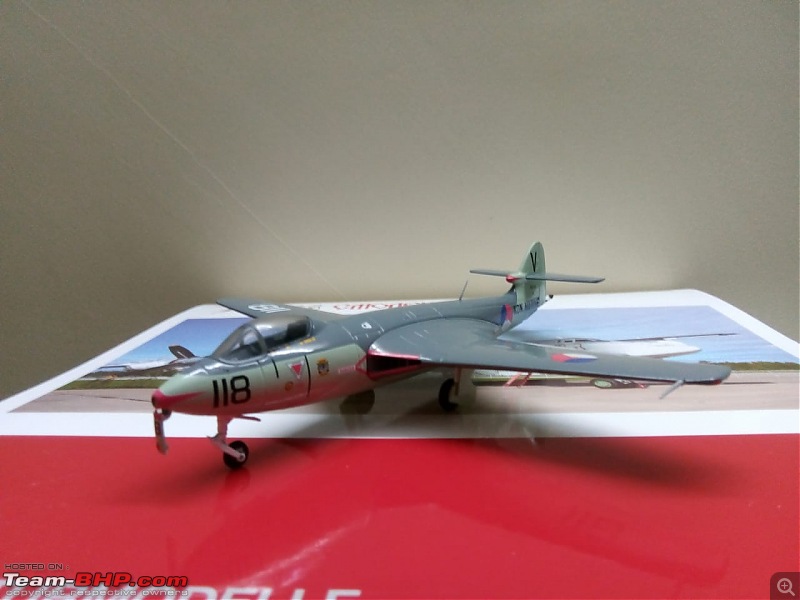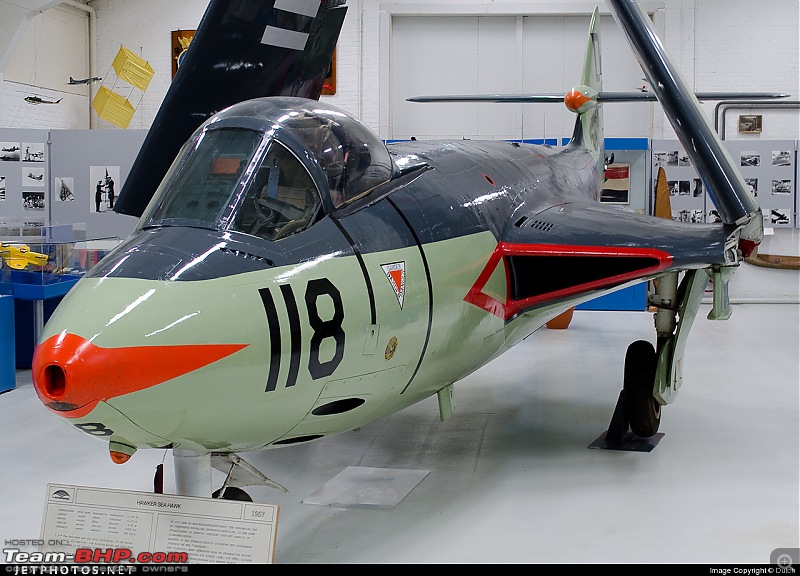| |||||||
| Search Forums |
| Advanced Search |
| Go to Page... |
 |
| Search this Thread |  834,884 views |
| | #841 | |
| BHPian Join Date: May 2009 Location: NYC / Lucknow
Posts: 704
Thanked: 4,129 Times
| Scale Models - Aircrafts & Ships Quote:
 What are the two vertical rods in the fronts? some aerials for radar or communication ? What are the two vertical rods in the fronts? some aerials for radar or communication ?1:200 Finnair Airbus A350-941 Registration: OH-LWA 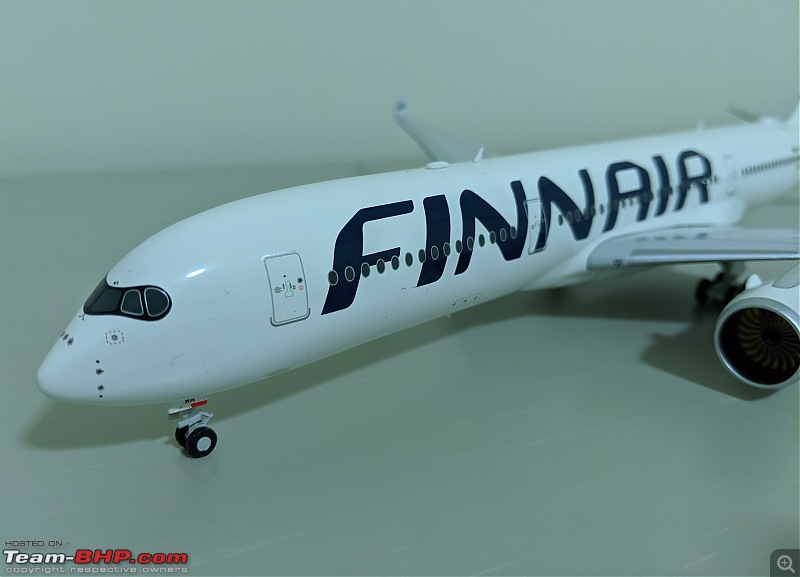 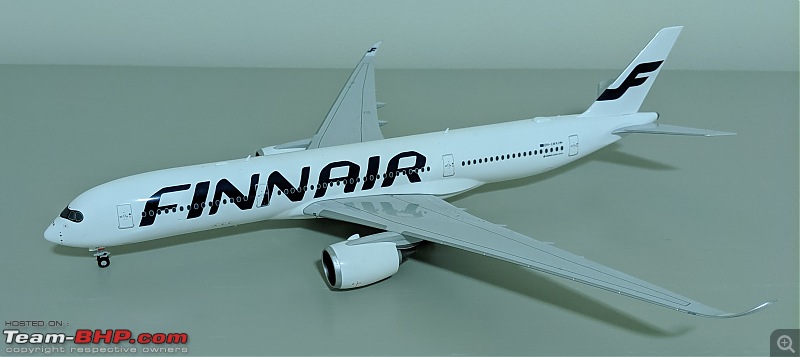 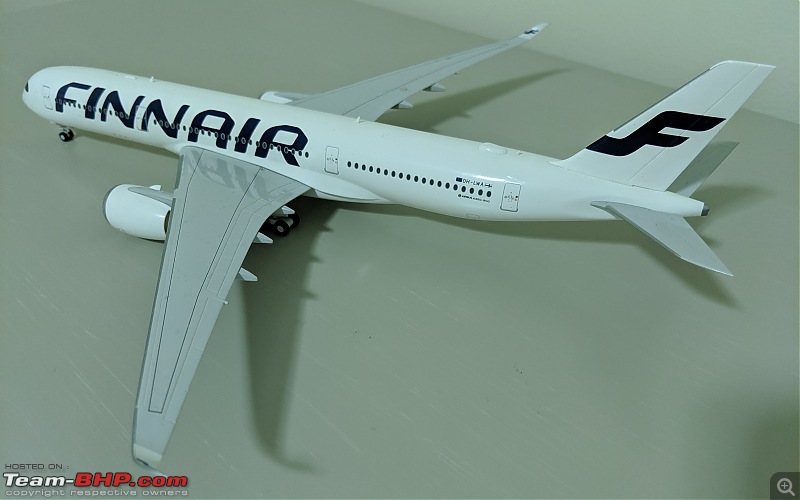 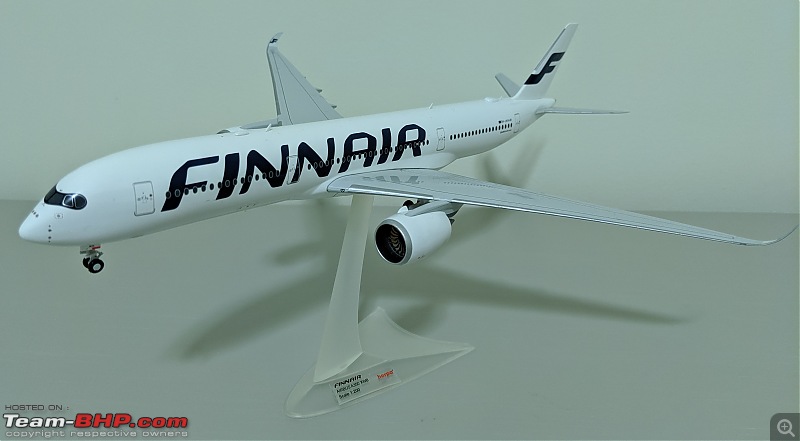 The Real plane. 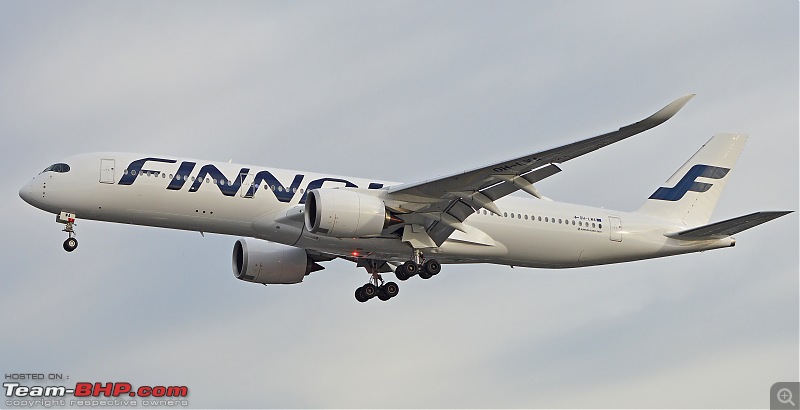 I ordered it thinking it was a diecast model from Herpa but later realised it was a plastic model. However the detailing is top class with all the aerials and fine printing. On the downside the price is close to a diecast model so its best to spend a bit more and go for the best. 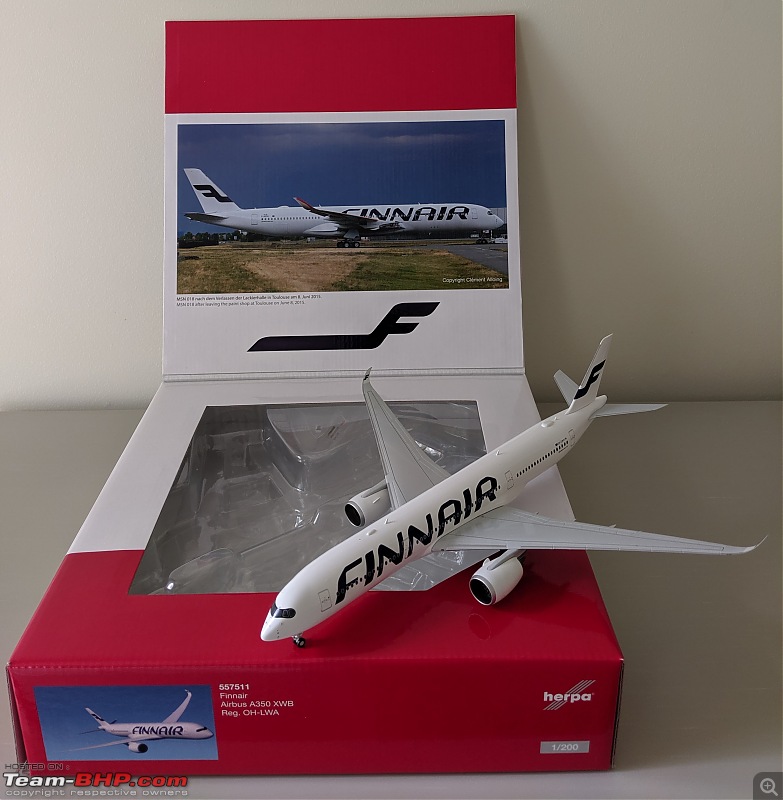 | |
| |  ()
Thanks ()
Thanks
|
| |
| | #842 |
| BHPian Join Date: Sep 2010 Location: New Delhi
Posts: 348
Thanked: 891 Times
| re: Scale Models - Aircraft, Battle Tanks & Ships |
| |  ()
Thanks ()
Thanks
|
| | #843 | |
| Distinguished - BHPian  Join Date: Aug 2014 Location: Delhi-NCR
Posts: 4,330
Thanked: 72,416 Times
| re: Scale Models - Aircraft, Battle Tanks & Ships
Oh My God!! What a forgetful goonk I am.  Quote:
 . In Dutch service the Seahawks flew off Karel Doorman a close sister ship to our own INS Vikrant. The Karel Doorman later flew under the Argentinian flag. The Dutch Navy even managed to equip their Seahawks with early versions of the Sidewinder AAM. . In Dutch service the Seahawks flew off Karel Doorman a close sister ship to our own INS Vikrant. The Karel Doorman later flew under the Argentinian flag. The Dutch Navy even managed to equip their Seahawks with early versions of the Sidewinder AAM.In the 1940s, the time when the Seahawk was designed, it was still quite unclear as to where in the airframe should a jet engine sit. Today it seems obvious, but due to centre of gravity reasons and the need for a rear facing hot efflux that was short and not too long (loss of power), all this wasn't so clear then. Also the early centrifugal jet engines were short in length and large in diameter. The Seahawk was the first to come up with the then unique layout with engine at dead centre and the hot jet exhaust blowing out of the rear through a bifurcated tailpipe. It was an elegant solution - just what you'd expect from Sir Sydney Camm, its brilliant designer. Another great addition to your fleet of jet airliners. Clearly you are making full use of your visit!!The quality of plastic models is improving in leaps and bounds. Congratulations. | |
| |  ()
Thanks ()
Thanks
|
| | #844 | |
| BHPian Join Date: May 2009 Location: NYC / Lucknow
Posts: 704
Thanked: 4,129 Times
| Scale Models - Aircrafts & Ships Quote:
1:200 Lufthansa Airbus A350-941 Registration 'D-AIXA' 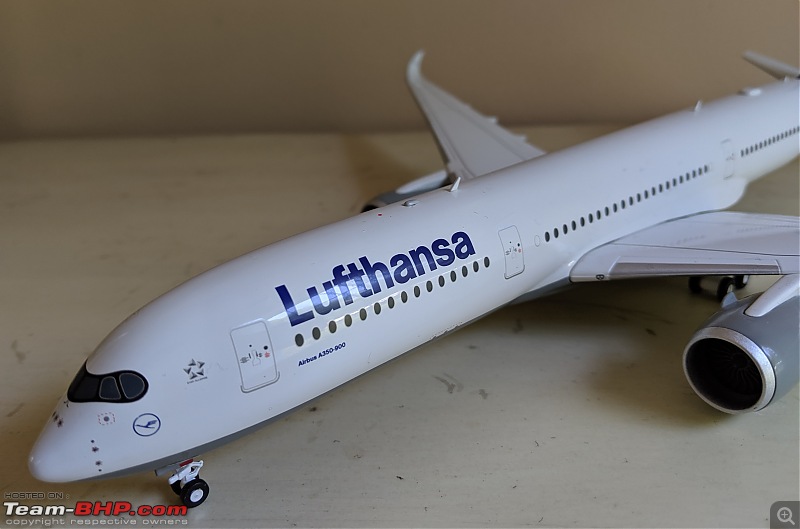 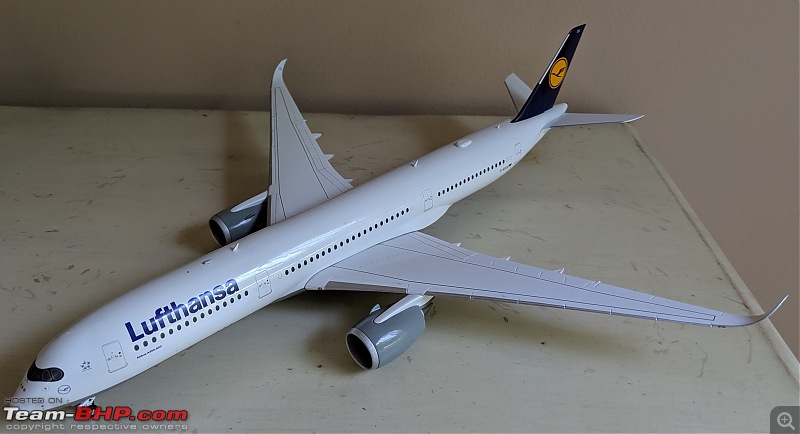 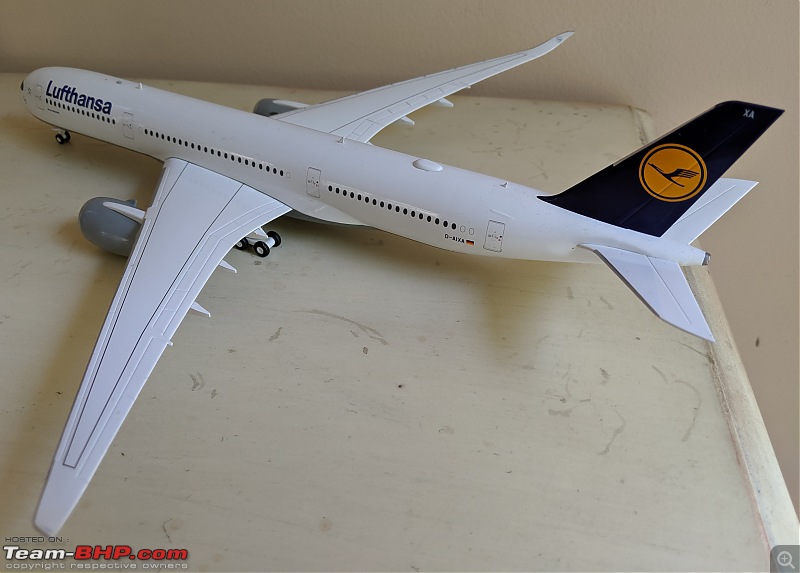 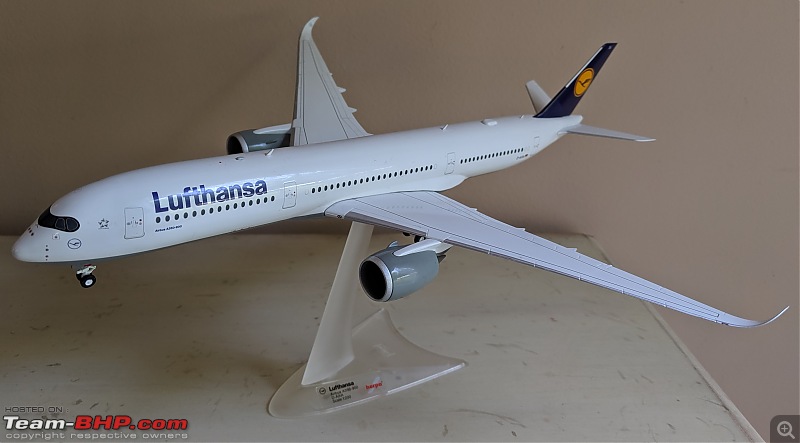 The Real Plane. 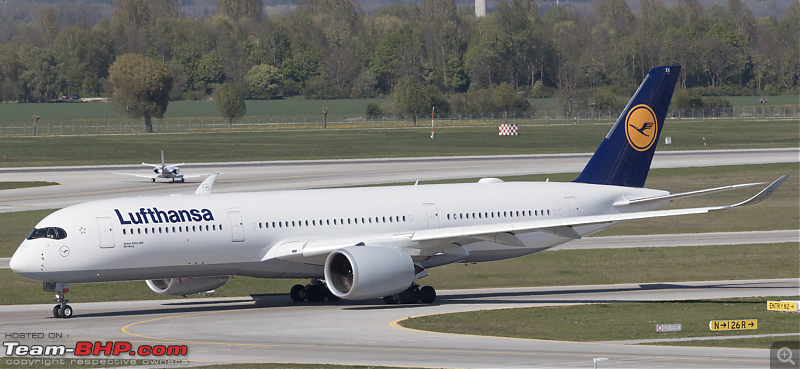 This is another Herpa plastic model I had ordered whose detailing matches diecast models. I had actually looked at the pics and thought it was diecast model and ordered it. 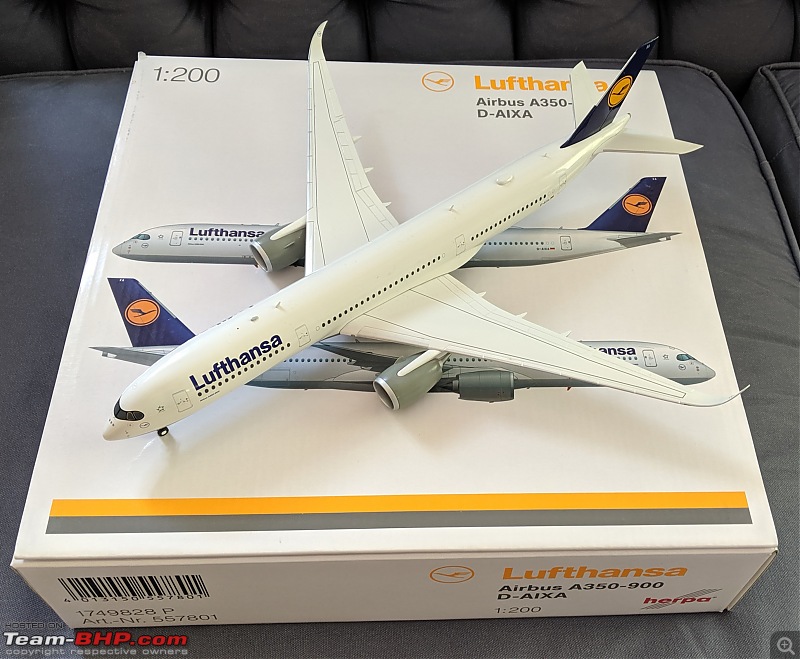 | |
| |  ()
Thanks ()
Thanks
|
| | #845 | |
| Distinguished - BHPian  Join Date: Aug 2014 Location: Delhi-NCR
Posts: 4,330
Thanked: 72,416 Times
| re: Scale Models - Aircraft, Battle Tanks & Ships Quote:
In the 1930s and 1940s aircraft collector models were typically made of wood. Then came metal diecast in 1947 pioneered by the Matchbox series of cars and in aircraft by the Dinky toys series. Corgi brought in transperancies for the cockpit, the pilot and underwing bombs etc. Now plastics, their mouldings and resins are getting so good that I think diecast will eventually go away. | |
| |  ()
Thanks ()
Thanks
|
| | #846 | |
| BHPian Join Date: May 2009 Location: NYC / Lucknow
Posts: 704
Thanked: 4,129 Times
| Scale Models - Aircrafts & Ships Quote:
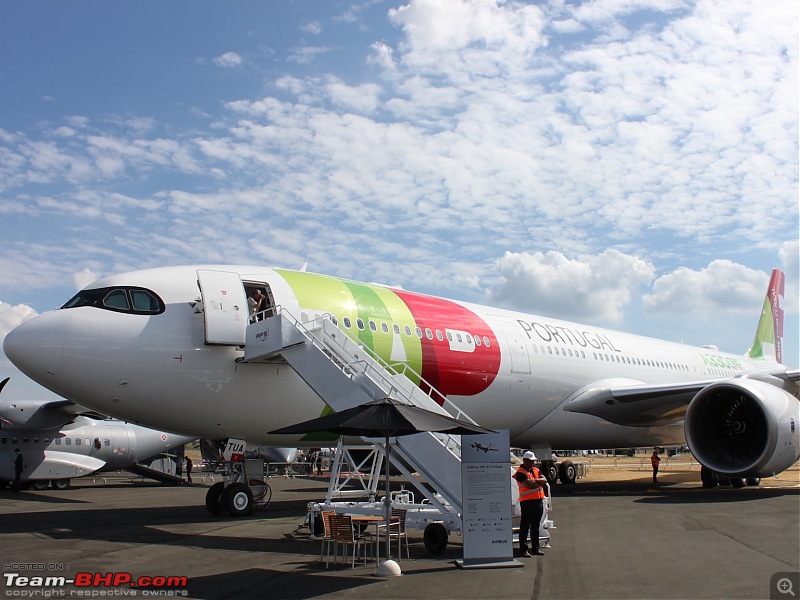 The A350 is definitely the best looking modern airliner, I had to take it out in my hotel room to admire and put on temporary display for a few days.  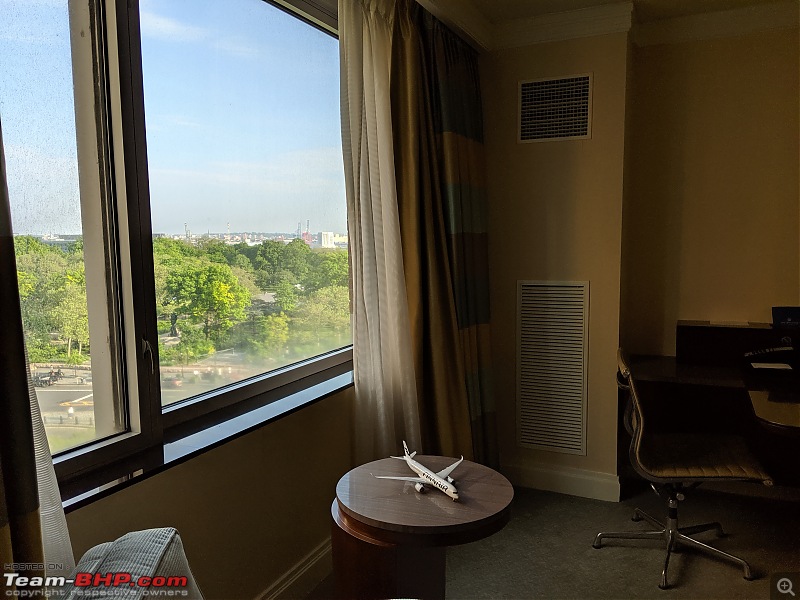 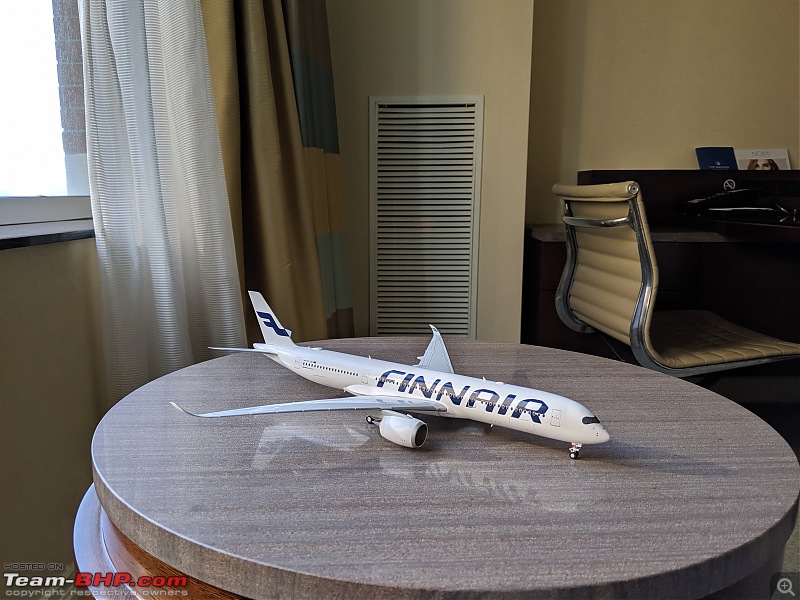 | |
| |  ()
Thanks ()
Thanks
|
| | #847 | |
| Distinguished - BHPian  Join Date: Aug 2014 Location: Delhi-NCR
Posts: 4,330
Thanked: 72,416 Times
| re: Scale Models - Aircraft, Battle Tanks & Ships Quote:
Those raccoon eyes look nice on the A320 NEO - I like them there more than on the A350. It seems like a marketing action by Airbus now that a very high proportion of airliners are twin engined ones and all look similar to most passengers. Lockheed had tried it with the L-1011 Tristar in the prototype (picture below) but it did not quite catch on. Dornier Do228 has it too. These are the two I can recall. Happy shopping. | |
| |  ()
Thanks ()
Thanks
|
| | #848 | ||
| Senior - BHPian | re: Scale Models - Aircraft, Battle Tanks & Ships Quote:
Quote:
Outstanding looking Sea Hawk model. I wish AV72 had made one in Indian Navy livery. Speaking on IN Sea Hawks, if anyone wants to read more about it, there's an outstanding book called "Downwind, Four Green" by V/Adm Vinod Pasricha. It is an encyclopedia on the Sea Hawk in IN service. I was lucky enough to get a copy by autographed the Vice Admiral himself. Those A350s look beautifully detailed. It is difficult to say that it is plastic and unless one sees it up close of touches it, one will easily mistake it for a diecast metal model. Congratulations!!! 1:100 McDonnell Douglas/Boeing F-15C Eagle 85-0102 "Gulf Spirit" 58th Tactical Fighter Squadron "Mighty Gorillas", 33rd Fighter Wing "Nomads", United States Air Force The McDonnell Douglas built F-15 Eagle first flew in July 1972, and entered service in 1976. It is among the most successful modern fighters, with over 100 victories and no losses in aerial combat, with the majority of the kills scored by Israeli Air Force F-15s. During Desert Storm F-15C Eagle 85-0102, assigned to the 58th TFS, 33rd TFW, scored three air to air victories. First on January 29, 1991- Captain David Rose of the 33rd FW downed an Iraqi MiG-23 using an AIM-7M Sparrow. The second and third victories came on February 7, 1991 when Captain Anthony Murphy of the 36th FW shot down two Su-22’s using two AIM-7Ms. F-15C 85-0102 was assigned to Colonel Rick Parsons Commander of the 33rd TFW and bears his name but his victory over an Su-22 came in another F-15C 84-0124. Three Iraqi flags represent Rose and Murphy’s kills and the green star is Colonel Parsons’. 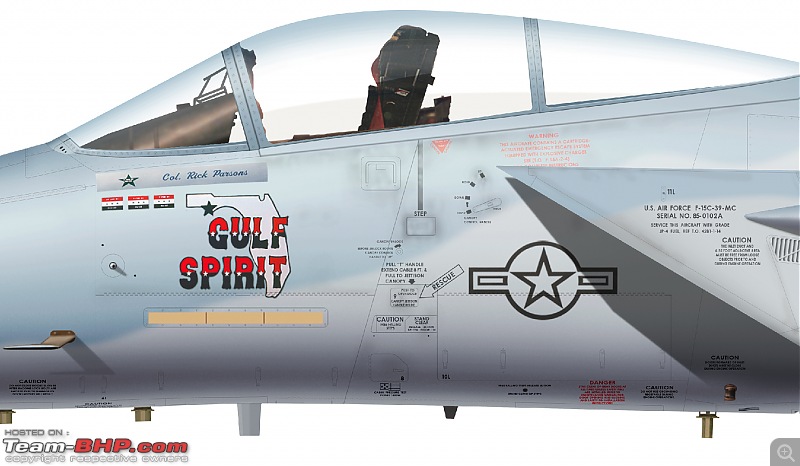 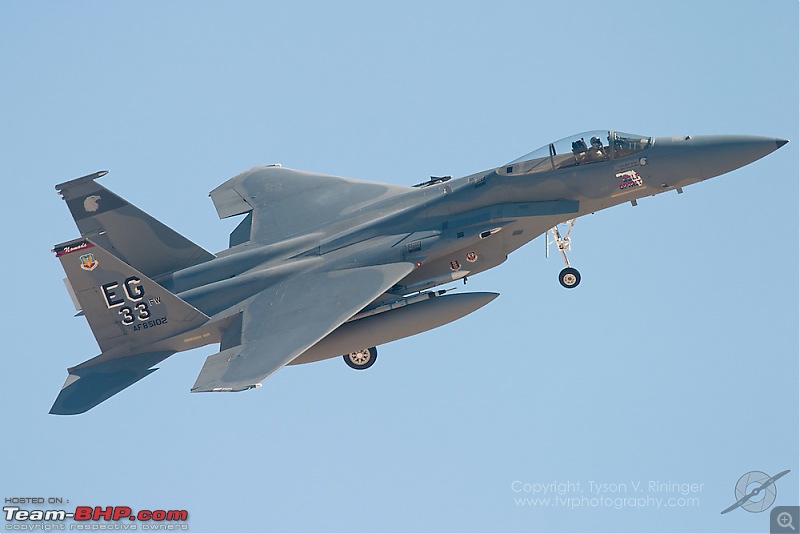 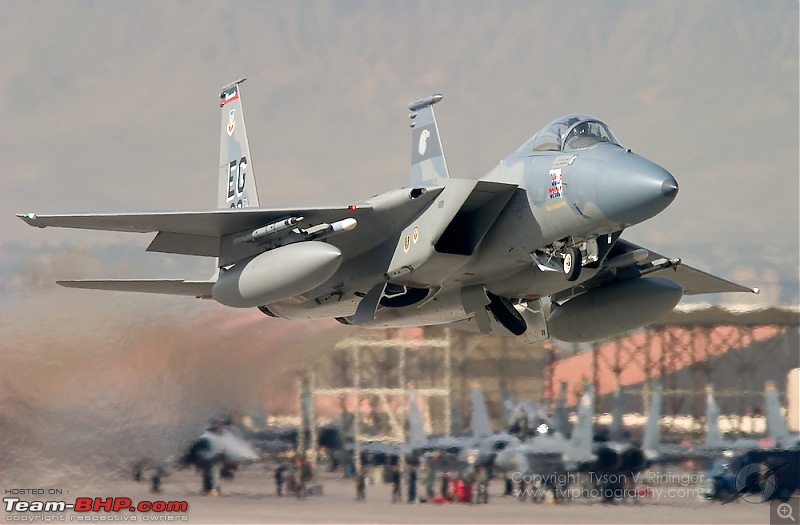 For the price I paid for it on Aliexpress, I am pretty happy with it(INR 1300 odd). It is no where close to JC or HM F-15s in terms of quality or feel, but still looks pretty decent for the price. The only reason why I picked it up was because this particular aircraft had scored 3 confirmed air to air kills in the first Gulf War. The Model: 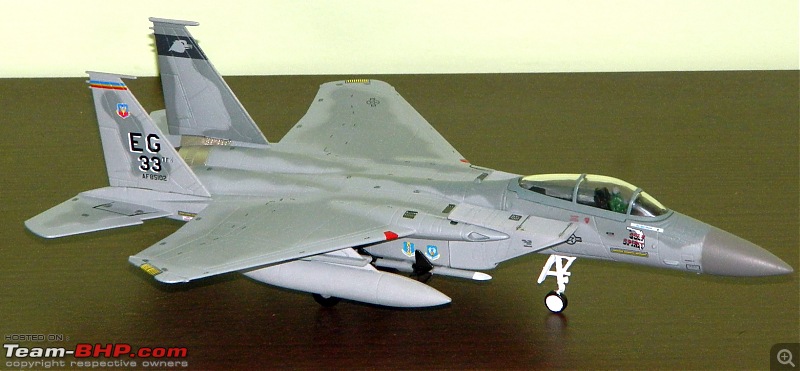 Close up on the Nose Art and kill markings 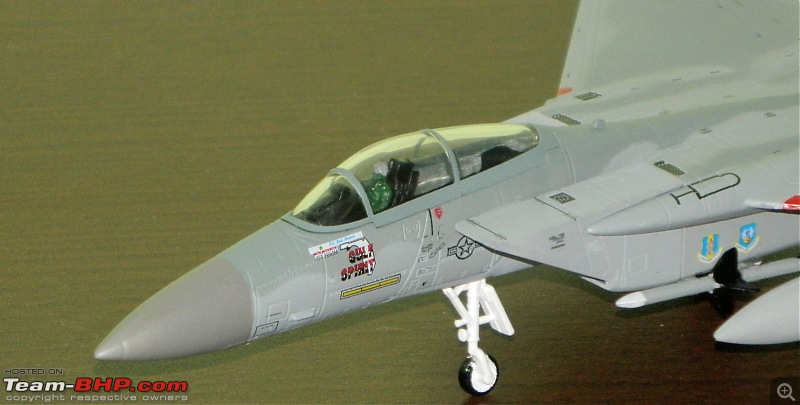 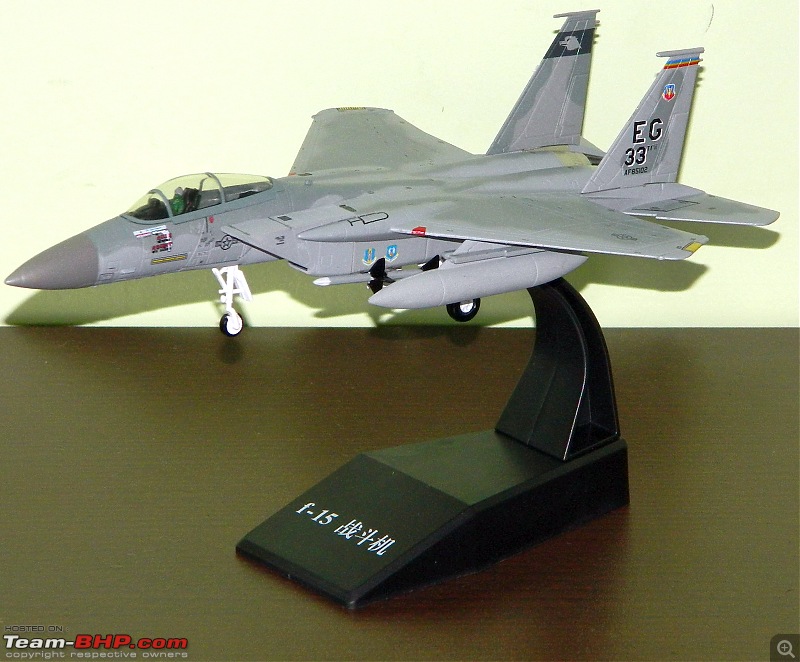 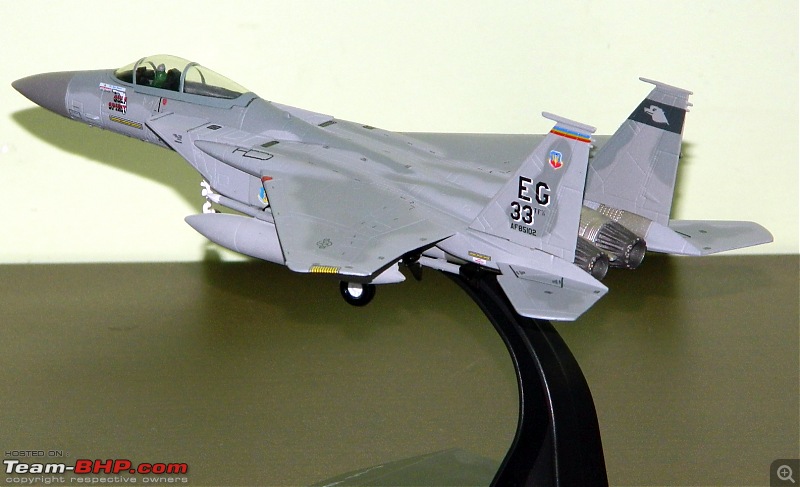 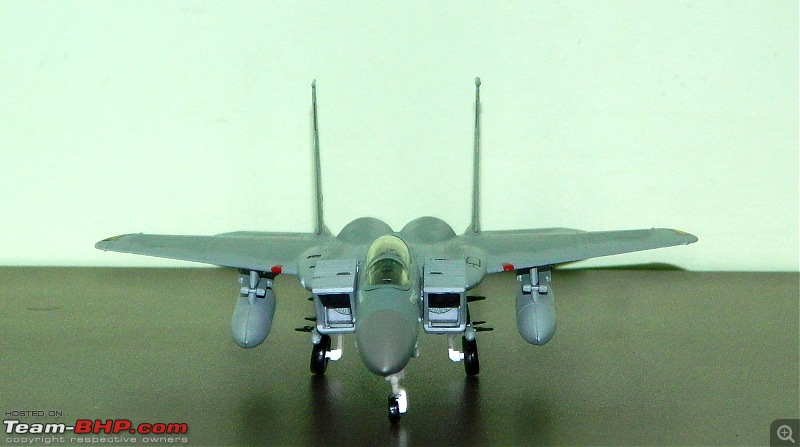 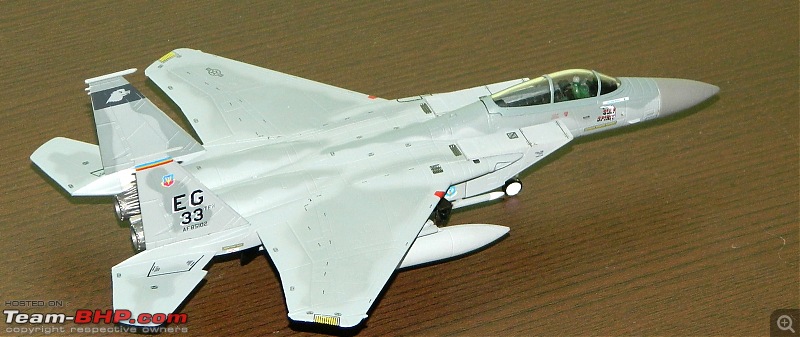 Liked the detailing under the engine. Model armed with 4 X AIM-7 Sparrows, 2 X 2300 litre F-15 drop tanks. Wished they had provided AIM-9 missiles on the wing pylons - and completed the standard F-15 air superiority loadout for the model. 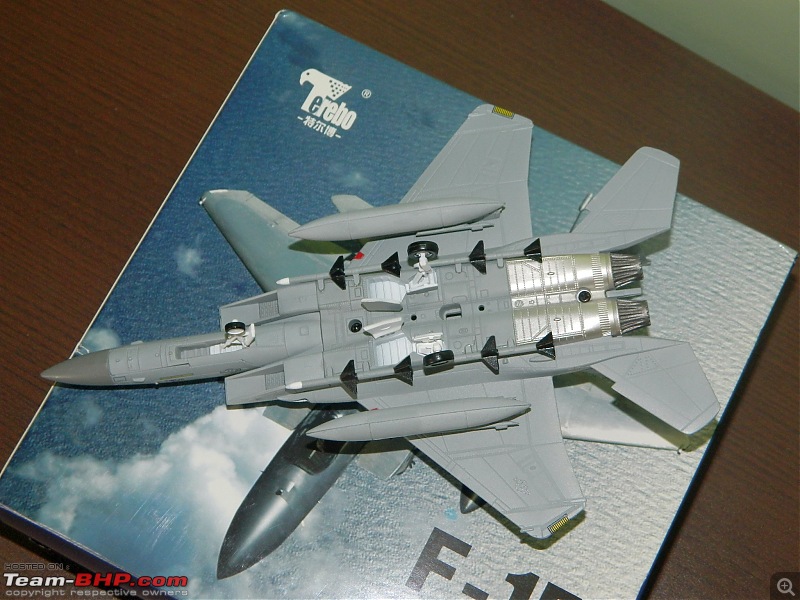 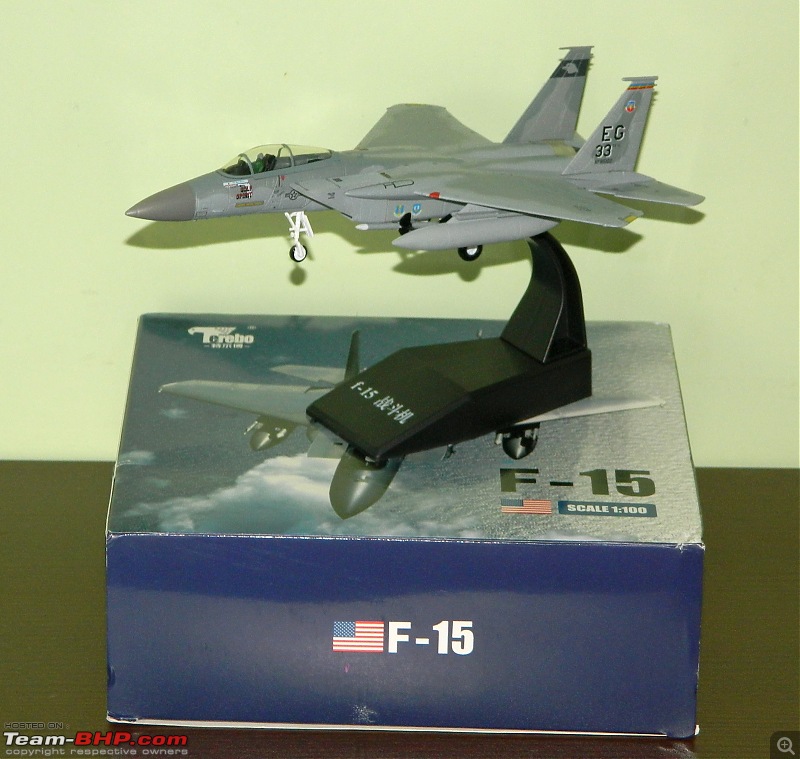 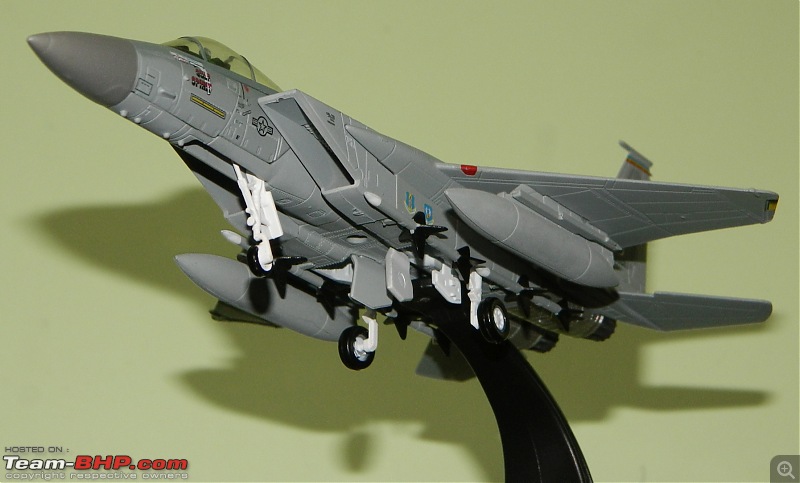 EG tail code represents Eglin AFB, Florida - home of the the 58th TFS & 33rd TFW. Note the Eagle logo the inner side of the tail fins. 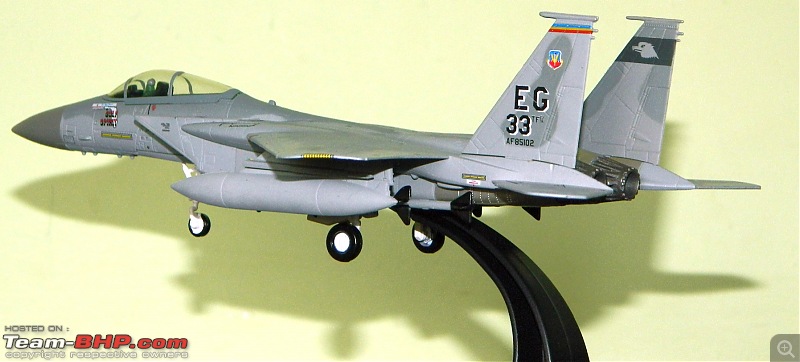 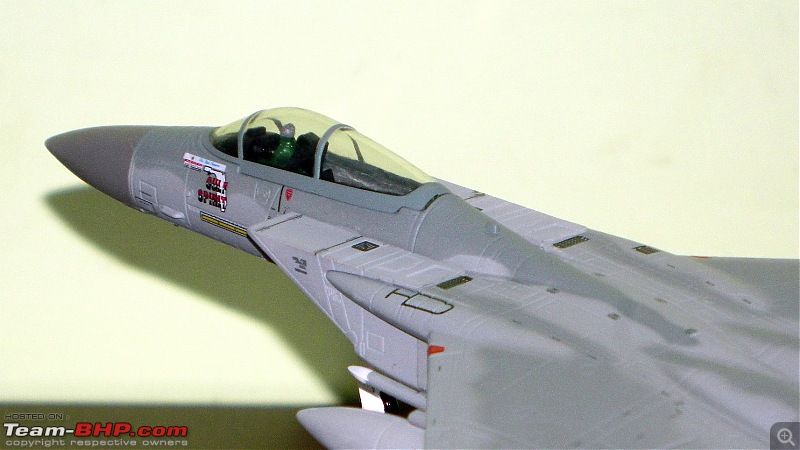 Last edited by skanchan95 : 21st May 2019 at 11:29. | ||
| |  ()
Thanks ()
Thanks
|
| | #849 |
| Senior - BHPian | re: Scale Models - Aircraft, Battle Tanks & Ships 1:72 Lockheed Martin F-16C Block 30 Fighting Falcon USAF 18th Aggressor Squadron "Arctic Bandits",354th Fighter Wing, #86-0310 Red 10, Eielson AFB, Alaska (Witty Wings) Designed by General Dynamics as a lightweight, daytime USAF air-combat fighter, the F-16 was first flown on January 20th, 1974. This single-engine, supersonic aircraft has, over the years, evolved into a multirole aircraft. It has a frameless bubble canopy—giving its pilot superior visibility—and it uses advanced aerodynamics. The F-16 was one of the first designs to use a relaxed static stability/fly-by-wire system, which helps it pull 9-g maneuvers and achieve speeds of more than Mach 2. Called "Viper" by its pilots, the F-16 is considered one of the most successful aircraft designs of the Cold War, with 4,400+ aircraft built since 1976. 18th Aggressor Squadron 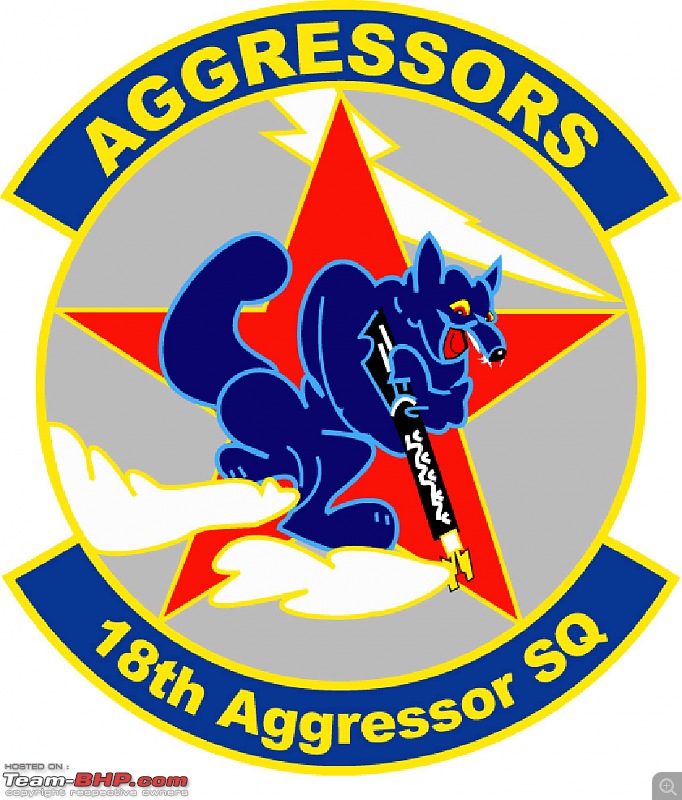 The US Air Force 18th Pursuit Squadron was activated in February 1940, flying the P-36 Hawk out of Moffet Field, California. The unit relocated to Elmendorf Field, Alaska in February 1941 and was redesignated 18th Fighter Squadron in May 1942. The squadron transitioned through a variety of front-line fighters, including the P-51 Mustang, F-86 Sabre, F-102 Delta Dagger and F-4 Phantom II; stationed at a variety of bases in Alaska. They moved to Eielson AFB in January 1982, flying the A-10 Thunderbolt II, before upgrading to the F-16 Fighting Falcon in 1991. In August 2007, the unit was redesignated 18th Aggressor Squadron in recognition of its current role of simulating foreign air force flying and fighting styles in training missions for USAF pilots. The 18th Aggressor Squadron is apart of the 354th Fighter Wing, 11th Air Force. F-16C 86-0310 Type : F-16C Block 30 First Flight : 13 January 1988 History : Delivered to 80th TFS "Headhunters" in February 1988. In March 2008, it was delivered to 18th Aggressor Squadron 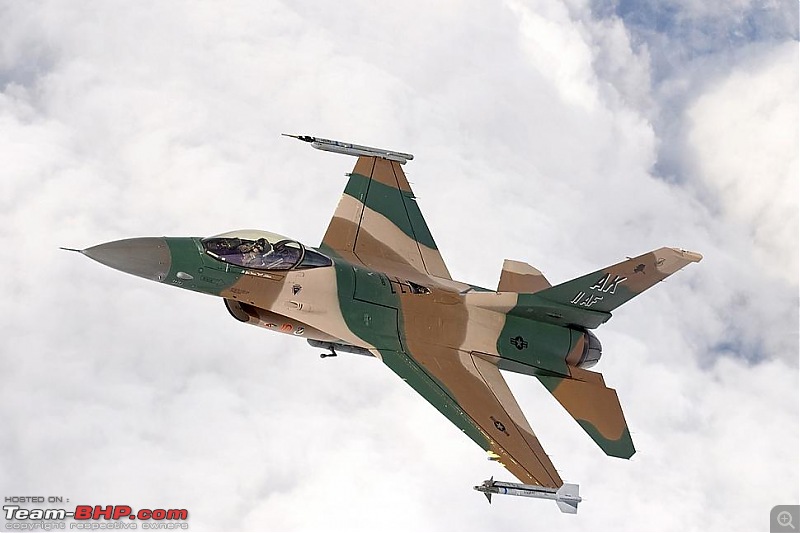 The Model The model box also has two GBU-31 JDAMs in case one wishes to mount it in place of the inner most AIM-9s. I wish the model had come with atleast one ACMI pod to accurately depict an Aggressor F-16. 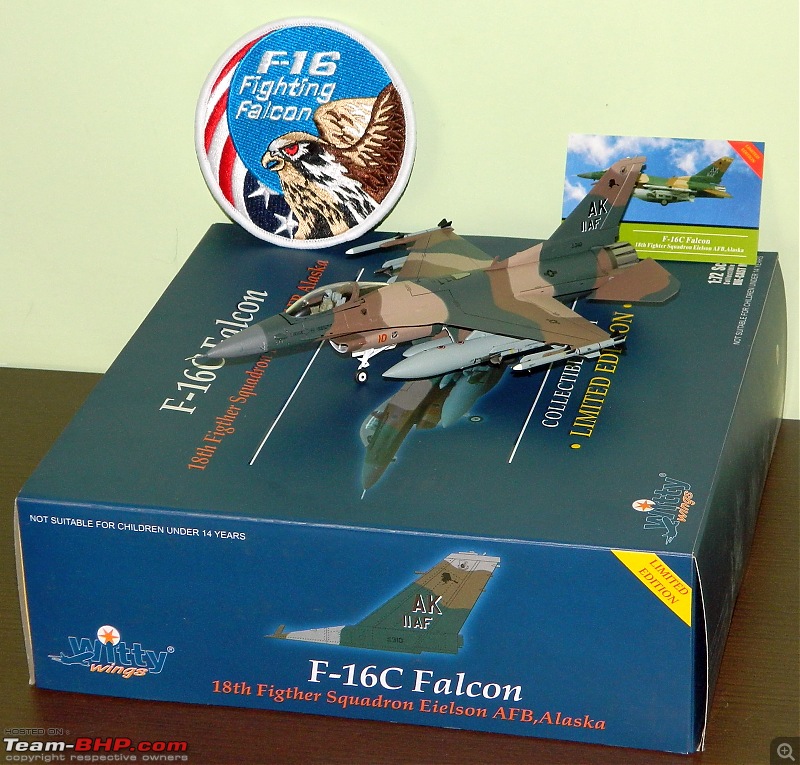 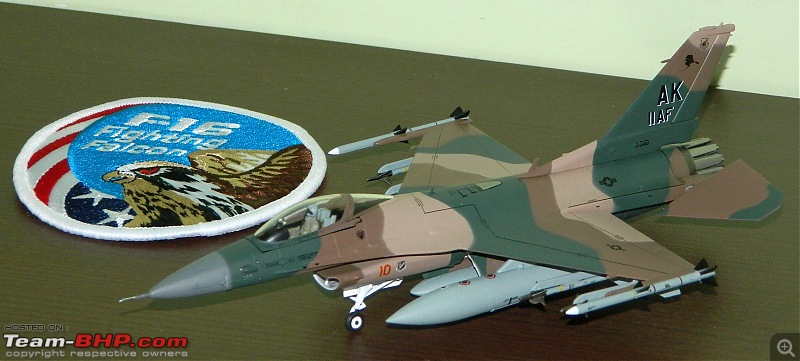 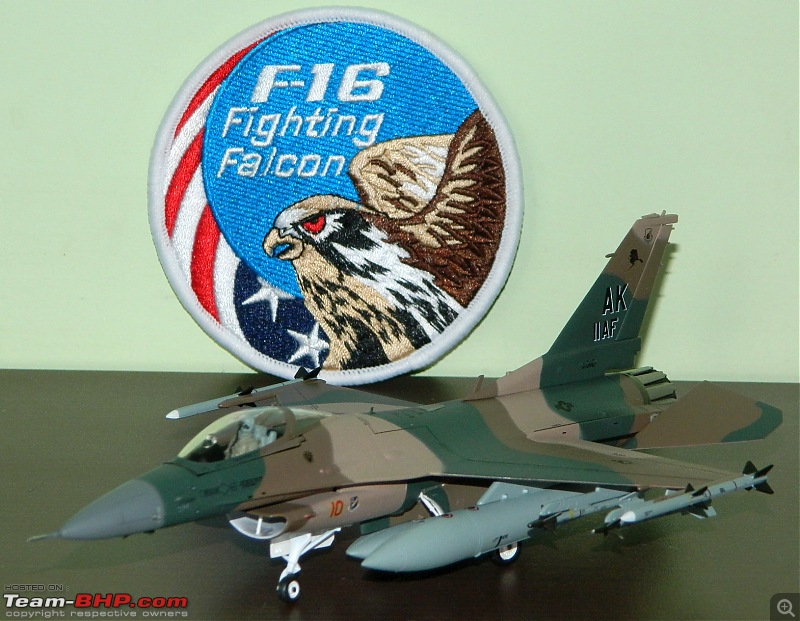 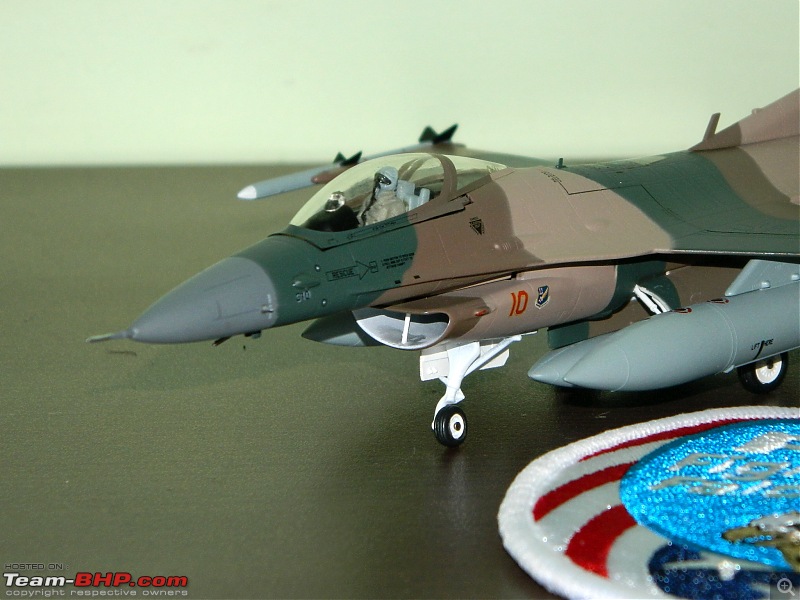 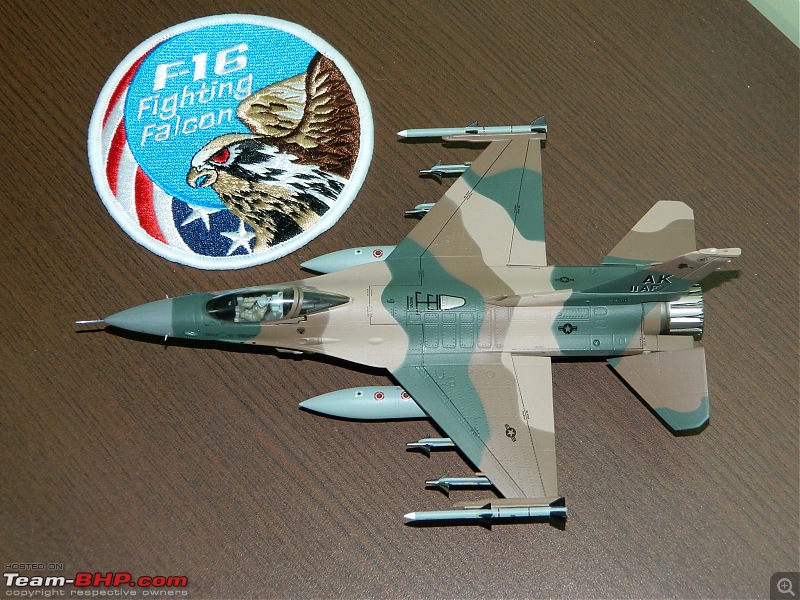 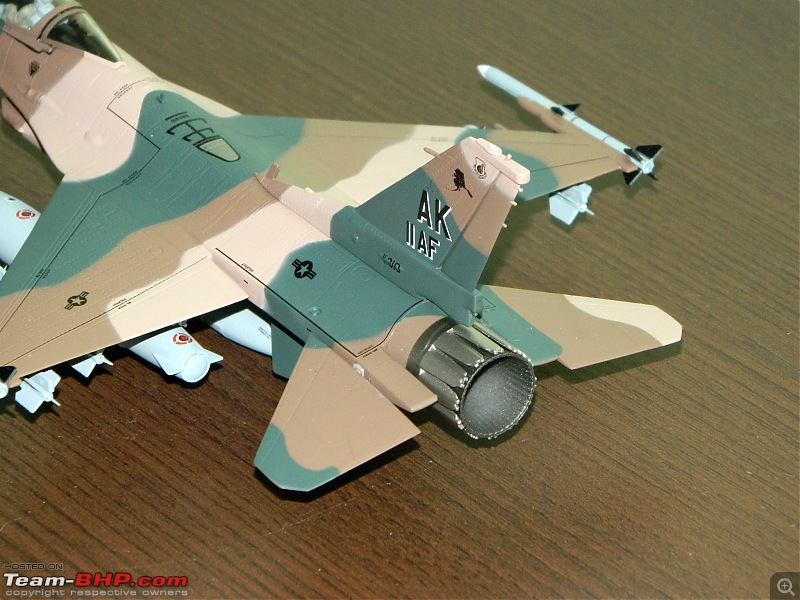 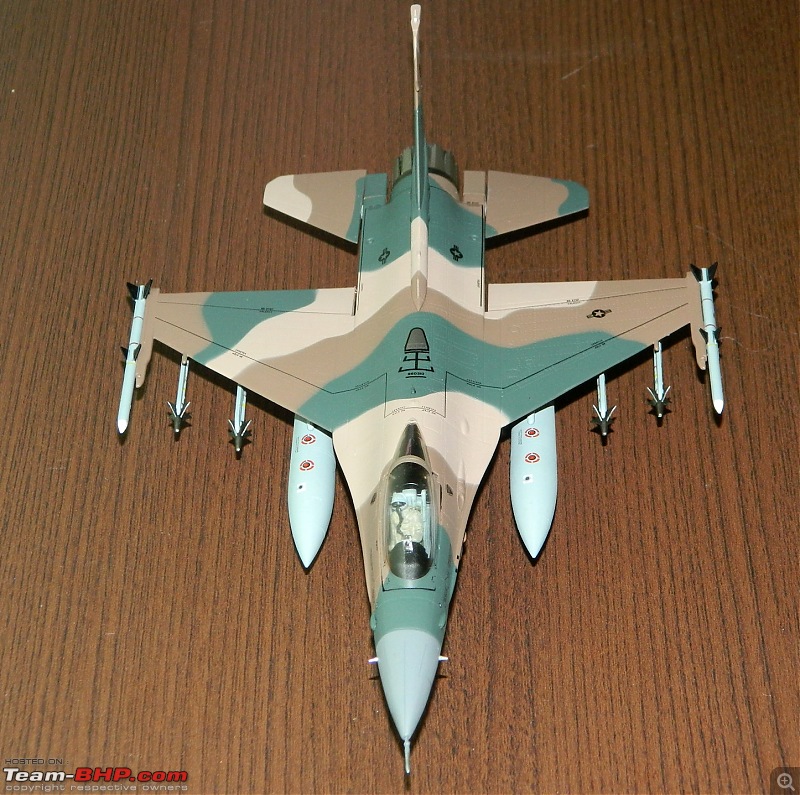 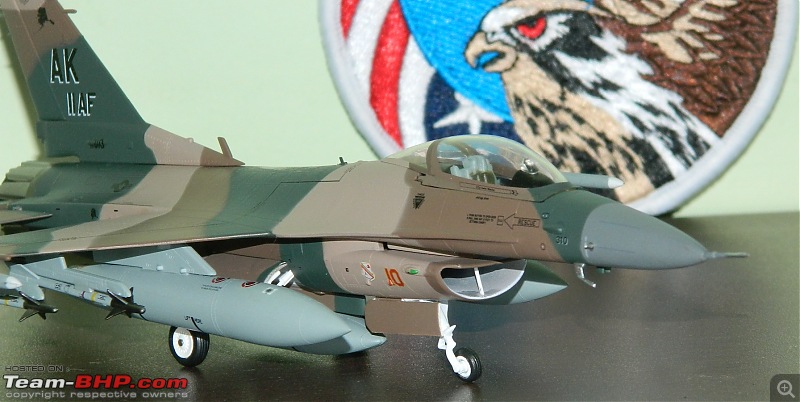 Loadout : 2 X AIM-120 AMRAAMs, 4 X AIM-9 Sidewinders, 2 X 370 gallon F-16 drop tanks, 2 X GBU-31 JDAMS (optional) 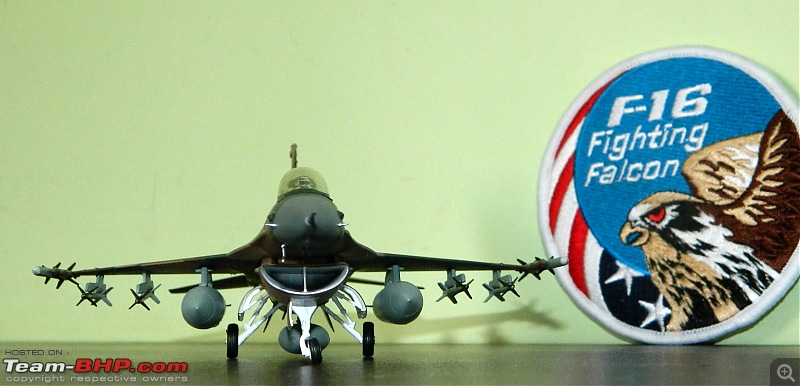 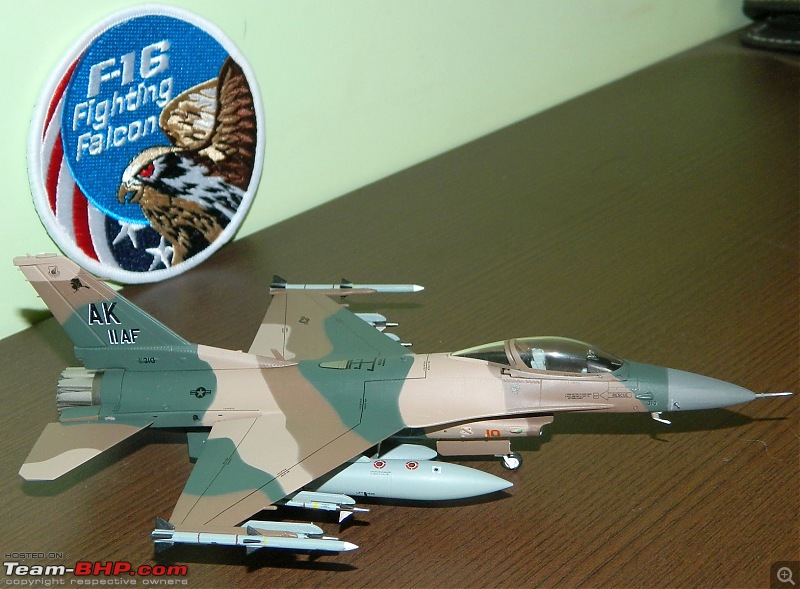 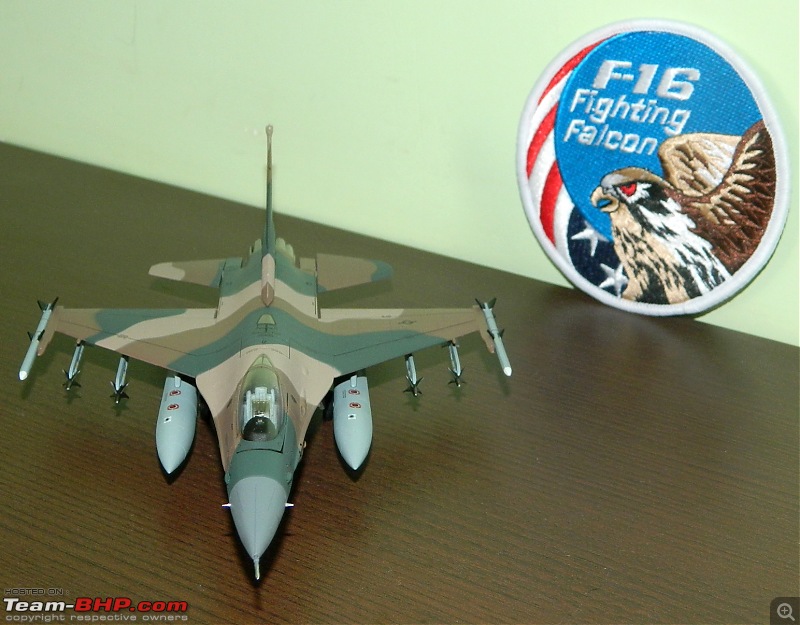 551st of 600 manufactured 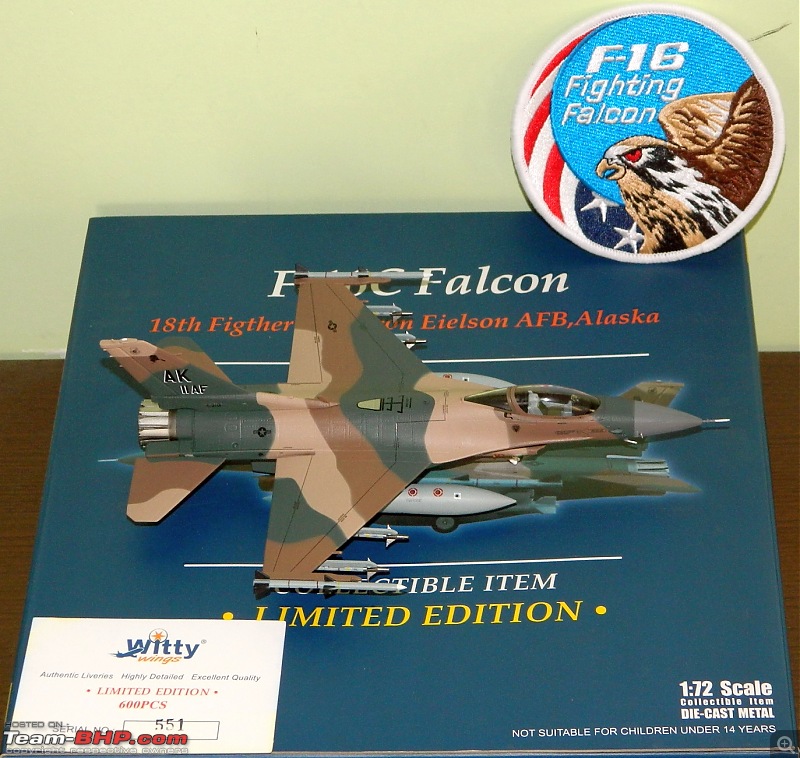 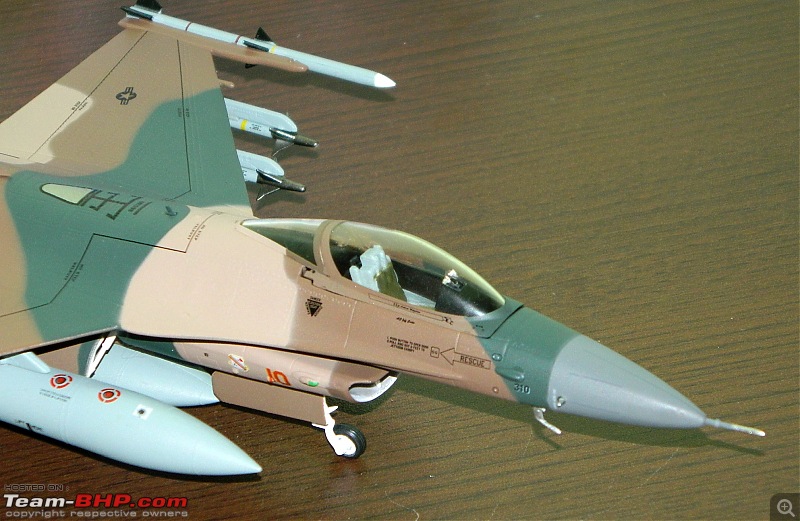 |
| |  ()
Thanks ()
Thanks
|
| | #850 | |||
| Distinguished - BHPian  Join Date: Aug 2014 Location: Delhi-NCR
Posts: 4,330
Thanked: 72,416 Times
| re: Scale Models - Aircraft, Battle Tanks & Ships Quote:
Quote:
Quote:
Congratulations on both your catches. Last edited by V.Narayan : 22nd May 2019 at 22:22. | |||
| |  ()
Thanks ()
Thanks
|
| | #851 | |
| BHPian Join Date: May 2009 Location: NYC / Lucknow
Posts: 704
Thanked: 4,129 Times
| re: Scale Models - Aircraft, Battle Tanks & Ships Quote:
 Would be nice to post your 1/100 collection of Hornets, Phantoms and Eagles. Would be nice to post your 1/100 collection of Hornets, Phantoms and Eagles.The missing sidewinders would have been good but the sparrows have sufficient detail on them for the scale. Thats a very striking livery, I think it is supposed to simulate Russian aircraft. The details on the weapons is great. I think this is the 2nd F-16 in your collection with a bold livery. Last edited by Foxbat : 24th May 2019 at 00:30. | |
| |  ()
Thanks ()
Thanks
|
| |
| | #852 |
| Distinguished - BHPian  Join Date: Aug 2014 Location: Delhi-NCR
Posts: 4,330
Thanked: 72,416 Times
| re: Scale Models - Aircraft, Battle Tanks & Ships Vought Corsair II A-7 :: Medium carrier borne attack aircraft, US Navy :: 1:72 JC Wings Delightful model, excellent detailing, most parts fitted easily with a snap-press some needed chiseling. Model size 7.5" length, 6.5" wingspan. The A-7 was supposed to replace the A-4 Skyhawk in the medium lo-lo attack role and was evolved from the successful F-8 Vought Crusader interceptor. On the whole it evolved into a competent aircraft but suffered from a low power loading which made taking off and sprinting a big challenge in hot ambient conditions of Vietnam & the Gulf. Between an ambient of 15 degrees centigrade and 35 degrees at sea level a jet turbine loses about 25%+ of its power. That maybe ok on a ship but in an aircraft it is horrible. Nevertheless for European environment it was a potent and dependable bomb carrier with a payload of 6800 kgs. The A-4 Skyhawk which it was to replace outlasted the A-7 and is still in service. The trick was in the two oldest open secrets of aviation design – light weight and the wing design. The Skyhawk excelled in both departments. Two aircrafts designed in the fifties that cracked the magic formula of a tailed delta – the A-4 and the MiG-21. Nevertheless the A-7 was a great bomb truck and dropped more bombs in Vietnam than any other American aircraft after the B-52 – 12,000+ sorties for a loss of only 6 aircraft. Where the A-7 stood out was in its avionics – moving map display, Inertial Navigation System (INS), radar-INS based bomb aiming system, head up display, Doppler navigation, automated carrier landing system and so on. For 1966 this was as advanced as it came. Only the F-111 and the Rockwell Vigilante could compare. In the 1970s it was viewed as a lo-lo attack master - a smaller version of the Blackburn Buccaneer of the UK. About 1500 odd were built with Greece being the last to retire them in 2014. Beautiful aircraft. Superbly reliable. Last edited by V.Narayan : 24th May 2019 at 19:46. |
| |  ()
Thanks ()
Thanks
|
| | #853 | |||
| Senior - BHPian | re: Scale Models - Aircraft, Battle Tanks & Ships Quote:
Quote:
 , as I acquired a Spitfire & Me109 also. They had been on my wish list for a long time , as I acquired a Spitfire & Me109 also. They had been on my wish list for a long timeQuote:
1:72 Messerschmitt Bf109G6 Luftwaffe 1./JG 27, Emil Klade (Witty Wings) Designed to meet a Luftwaffe need for a single-seat fighter/interceptor, the Messerschmitt Bf 109 was first flown on May 28th, 1935. Its all-metal construction, closed canopy and retractable gear made the Bf 109 one of the first true modern fighters of WWII. This versatile aircraft served in many roles and was the most produced aircraft of the war and the backbone of the Luftwaffe, and was flown by Germany's top three aces, who claimed a total of 928 victories between them. Armed with two cannons and two machine guns, the Bf 109's design underwent constant revisions, which allowed it to remain competitive until the end of the war. The highest scoring fighter ace of all time, Erich Hartmann, flew the Bf 109 and was credited with 352 aerial victories. The aircraft was also flown by Hans-Joachim Marseille, the highest-scoring German ace in the North African Campaign, who achieved 158 aerial victories. It was also flown by several other aces from Germany's allies, notably the Finn Ilmari Juutilainen, the highest scoring non-German ace on the type, and pilots from Italy, Romania, Croatia, Bulgaria and Hungary. The Aircraft Model 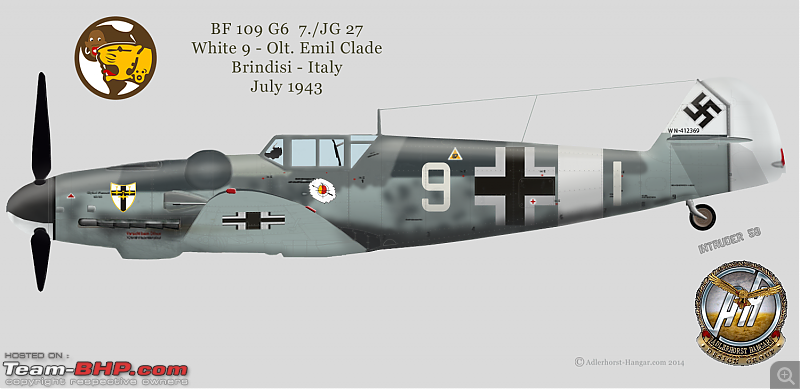 This particular Bf109G6 was flown by Hauptmann (Captain) Emil Josef Clade, an ace with 27 kills. Clade finished the war as with the rank of Hauptmann, and was credited with 27 victories, including two four-engine bombers. Nine claims were made over the Western Front, with the remainder being in North Africa. Clade was himself shot down six times, including in aerial combat on 5 October 1943 (during a mission resulting in his 18th victory), on 26 November 1944 and on 25 February 1945 (immediately after his 27th and last air kill). He also sustained severe injuries in a Resistance attack on 16 February 1944 when he was serving in France near Avignon. JG27 Jagdgeschwader 27 (JG 27) "Afrika" was a fighter wing of the air force of Nazi Germany (Luftwaffe) during World War II. It served in the North African Campaign, supporting the Afrika Korps.Although official records were lost at the end of the war, research suggests Jagdgeschwader 27 claimed over 3,100 kills for some 1,400 aircraft lost, and lost approximately 827 pilots killed, missing or POW during 1939-45.Twenty-four JG 27 pilots earned the Knight's Cross of the Iron Cross. The Nazi Swastika is missing on the tail fin, probably because displaying or being in possession of a Nazi Swastika is a crime in some countries. 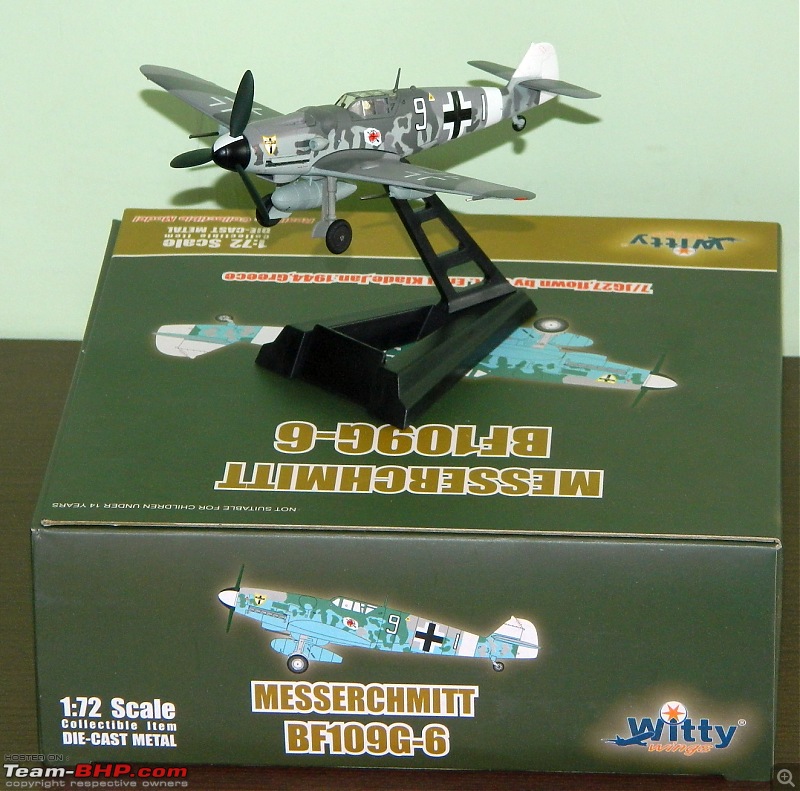 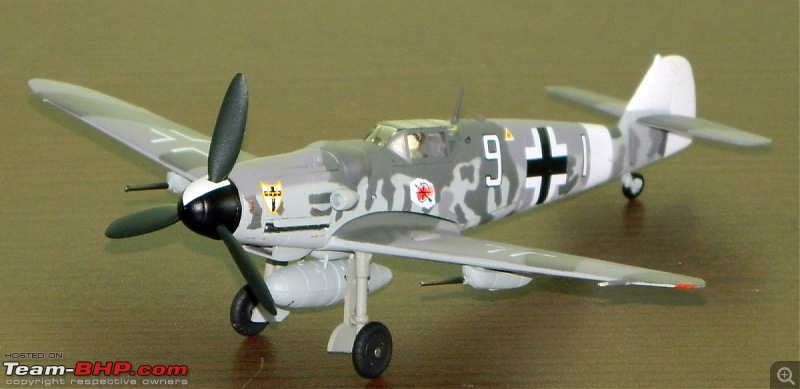 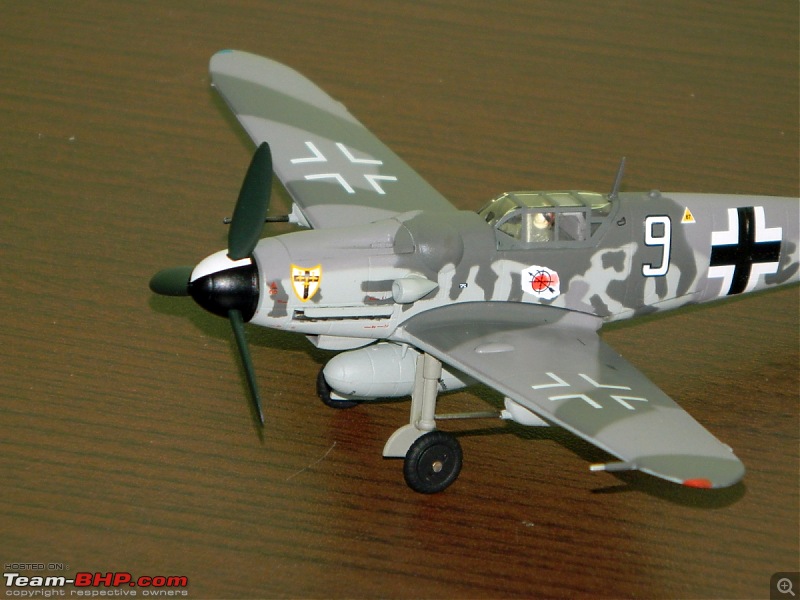 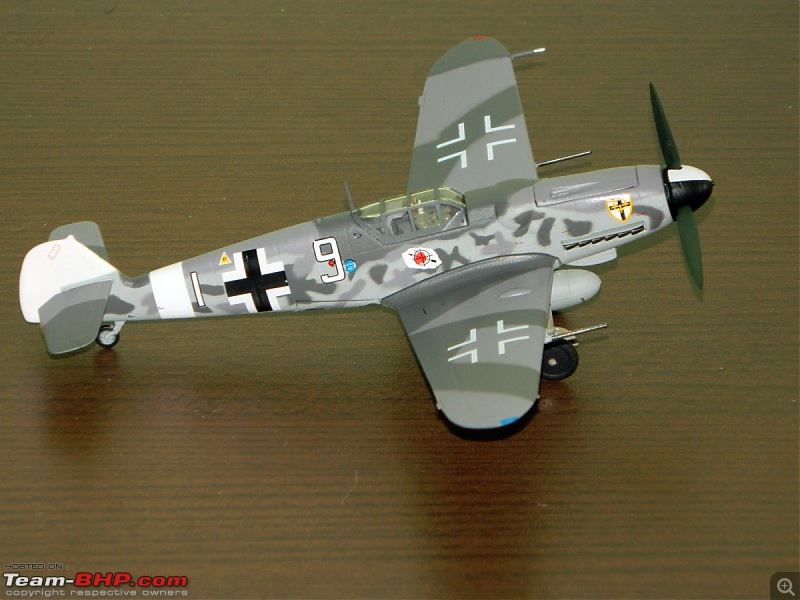 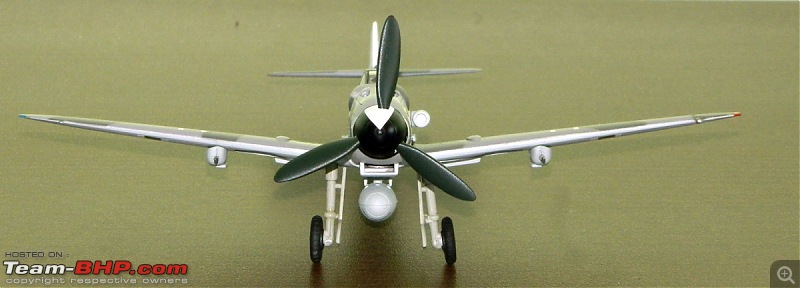 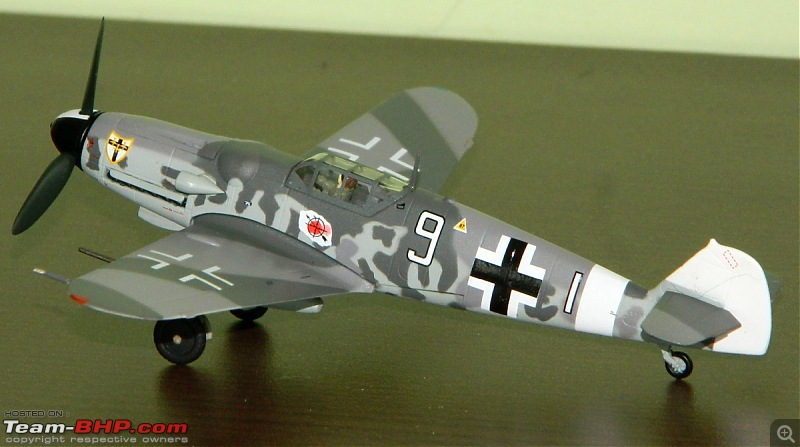 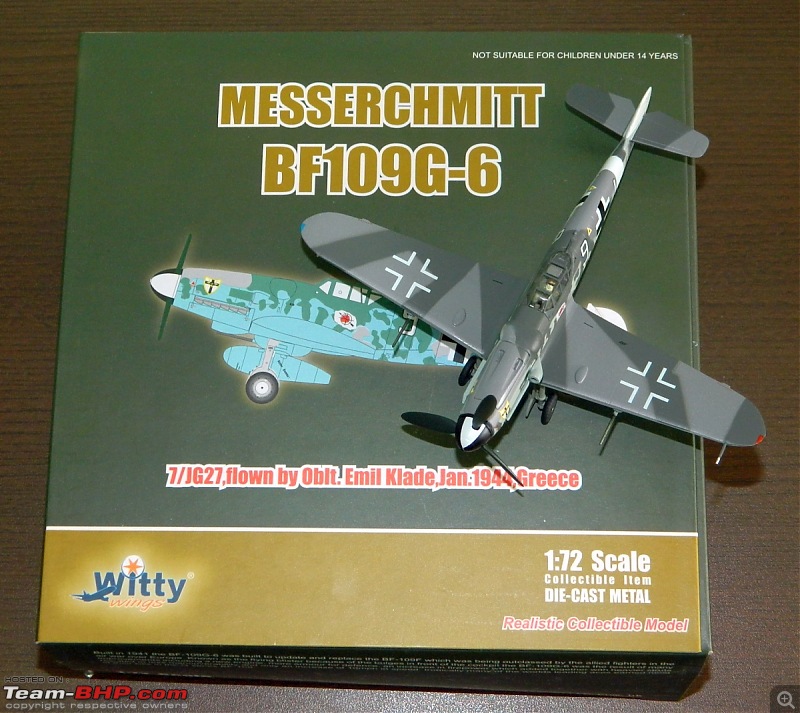 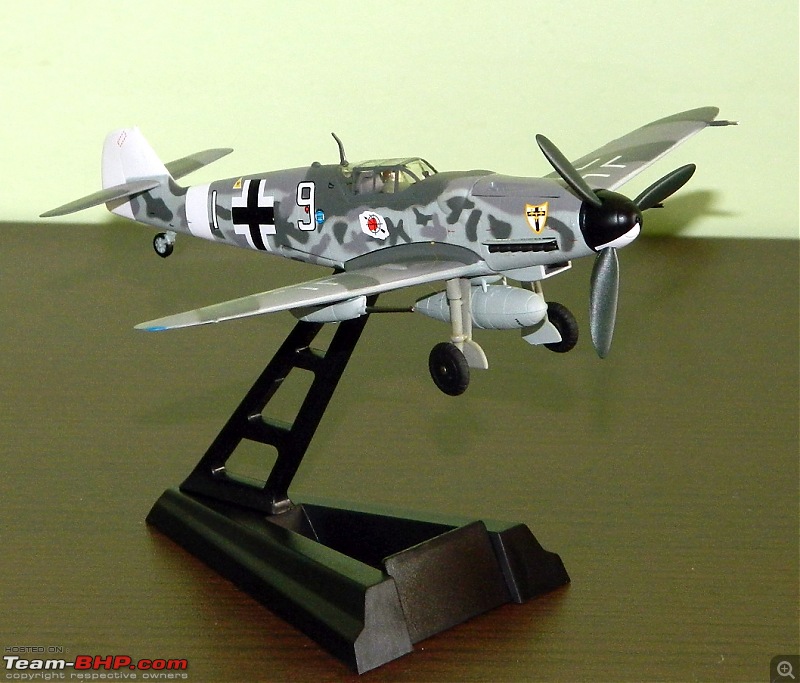 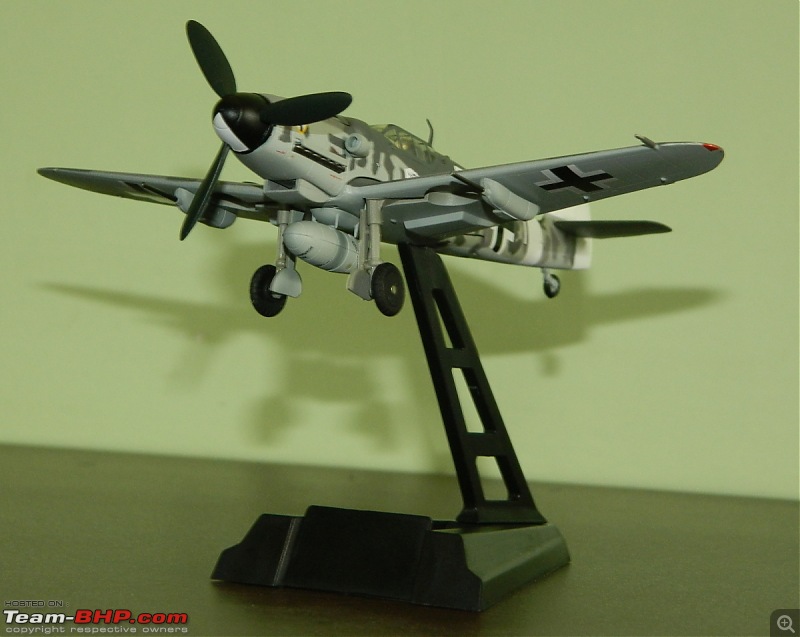 Some detailing on the underside: Achtung kraftstoffbehälter - Caution Fuel Tank 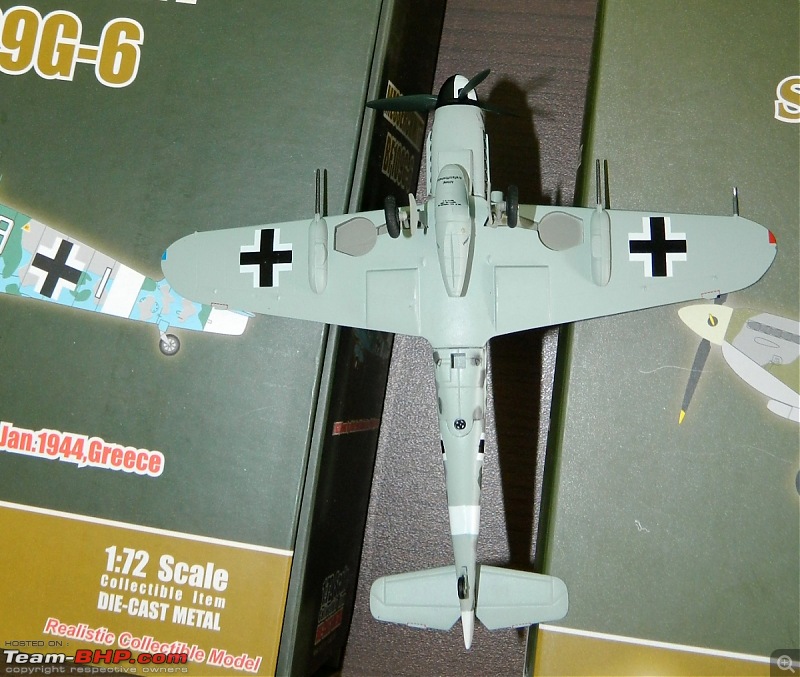 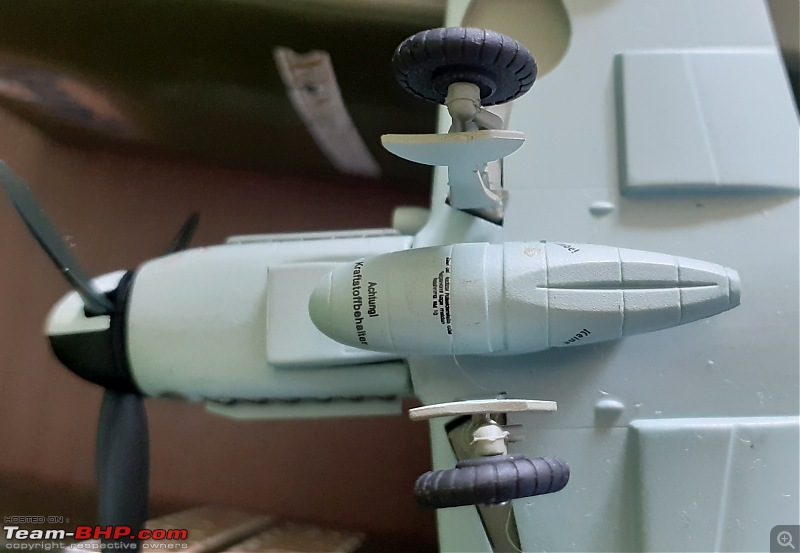 Keine Bombe! - Not a bomb! 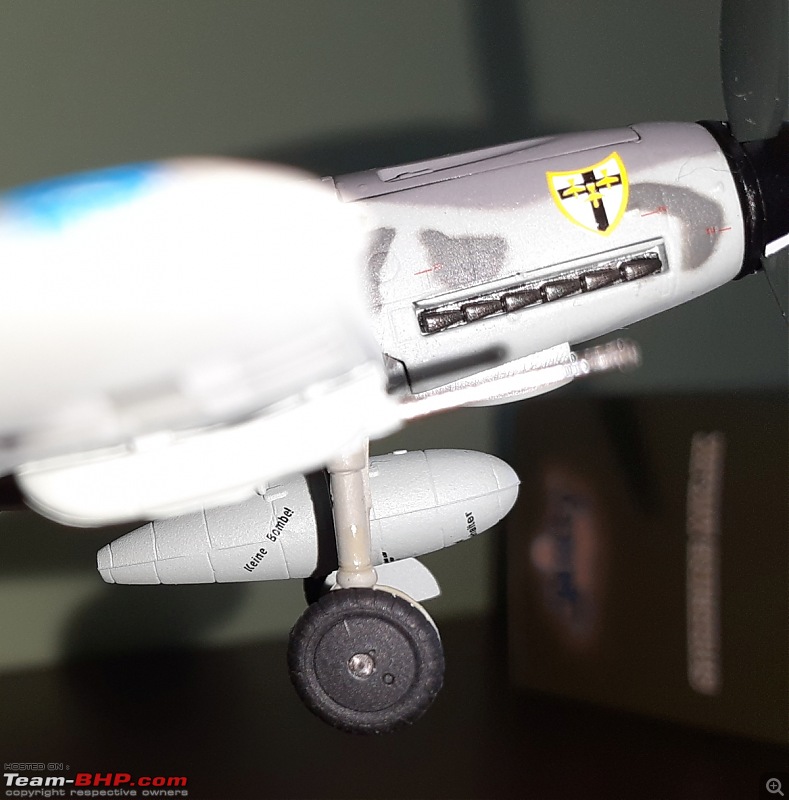 Last edited by skanchan95 : 25th May 2019 at 11:30. | |||
| |  ()
Thanks ()
Thanks
|
| | #854 |
| Senior - BHPian | re: Scale Models - Aircraft, Battle Tanks & Ships 1:72 Supermarine Spitfire Mk IX Diecast Model RAF No.611 West Lancashire Sqdn, BS435, 1942 (Witty Wings) Designed by R.J.Michell to meet a British Air Ministry specification, the Supermarine Spitfire first flown on March 5th, 1936. With its combination of beautiful fighter design, the excellent performance of its Rolls-Royce Merlin powerplant and firepower provided by twin cannons and four machine guns, the Spitfire became an unrivaled symbol of victory. The Spitfire had 40 major variants and was built in greater numbers than any other British aircraft of the time. It flew operationally on every front between 1939 and 1945 and was engaged in every one of the Royal Air Force's major actions. The German Focke-Wulf Fw190 single-seat fighter appeared suddenly and in large numbers in the skies over Northern France during the summer of 1941. Britain scrambled to create an airplane equal to this powerful, agile, high-altitude adversary. The MkVIII Spitfire, a much refined version of the MkV, was only in the early stages of production and it was put on hold. Instead, as a temporary stop-gap, measure beginning in 1942, Vickers fitted Spitfire MkVs with a larger Rolls-Royce Merlin engine, a two-stage supercharger and intercooler and a four-bladed propeller. This stop-gap Spitfire, the MkIX, actually stayed in production through 1944 and was produced in much larger numbers (5,665) than the MkVIII (1,658). There were three versions of the MkIX: THe LF (low-altitude) had a clipped wing; the F was the standard fighter version and the HF (high-altitude) had extended wings and a pressurized cockpit. No. 611 Squadron RAF No. 611 (West Lancashire) Squadron is a British Royal Air Force squadron. It was first formed in 1936 and was disbanded in 1957 after seeing combat as a fighter unit during the Second World War. It was reformed as a reserve squadron in 2013. The squadron was formed at RAF Hendon, Middlesex on 10 February 1936 as a day bomber unit. The squadron set up its permanent base at RAF Speke (now Liverpool John Lennon Airport) on 6 May and began recruiting personnel from Liverpool and the surrounding area. Its first Hawker Hart light bombers arrived in June, being replaced by Hawker Hinds from April 1938. On 1 January 1939, the unit became a fighter squadron, receiving its first Supermarine Spitfire Mk.I's in May. The squadron left for RAF Duxford on 13 August, as part of the Fighter Command's No. 12 Group, After a period of defensive duties on the east coast, No. 611 became fully operational from its RAF Digby base in Lincolnshire in May 1940, firstly over Dunkirk and then taking part in the Battle of Britain campaign with the Duxford Wing, 12 Group's 'Big Wing' formation. The squadron commenced offensive sweeps over occupied northern France in January 1941, based at RAF Hornchurch, moving to RAF Drem in Scotland for recuperation in November 1941. The unit moved south again in June 1942 to RAF Kenley for deployment on shipping reconnaissance, escort and defensive missions. For Operation Overlord (the Allied invasion of Normandy) it was equipped with the Spitfire V LF as part of Air Defence of Great Britain, though under the operational control of RAF Second Tactical Air Force. No. 611 provided covering patrols for the invasion from its base at RAF Deanland. The squadron then moved to south-west England for a short period. Long-range escort missions began to be flown from RAF Bradwell Bay, Essex, from late August 1944, until No. 611 moved to RAF Skeabrae in Orkney on 3 October. After converting to Merlin powered North American Mustang Mk.IV's the squadron again moved south, this time to RAF Hawkinge in Kent and resumed escort duties for the rest of the war. The squadron disbanded as an RAF squadron on 15 August 1945 at RAF Peterhead. Aircraft Model & its History Unit: 611 West Lancashire Squadron Royal Air Force Type: Spitfire IX Serial: BS435 Coded: FY-F Flying Pilot: Sq/Ldr. Hugo Throssell Armstrong DFC and Bar, RAAF, Age 26. Missing. 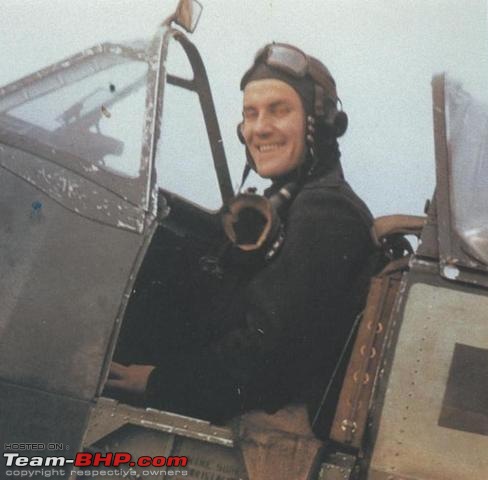 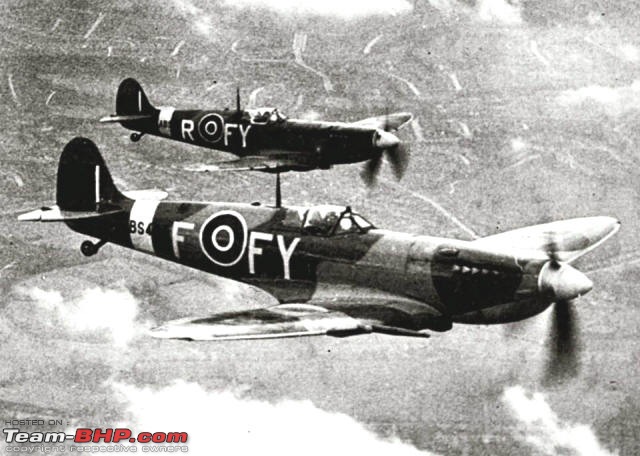 Hugo Armstrong (Nicknamed "Sinker") was the Australian Commanding Officer of 611 Sqdn and was credited with 12 kills during WW2, all of them whilst flying Spitfires and all with RAF squadrons. Of those, the last 3 were while flying Spitfire Mk IXs with No 611 Squadron at Biggin Hill. He was commissioned as a Pilot Officer in early part of 1941. He then served with 129 and 72 Squadron's until July 1942 when he was then posted as O.C. 611 Sqn. In the meantime his tally had reached 9 kills. The first occurring on the 21st September 1941 when he shot down a Bf109E over Le Torquet whilst escorting Bristol Blenheim bombers in a 129 Sqn Mk VB. The move to 611 Squadron gave him the opportunity to fly the Spitfire Mk IX and all of the other 3 victories using this mark plus a further 2 probables, were scored in his aircraft BS435/FY-F. The first of these were scored on the 2nd November 1942 when he claimed a FW 190 destroyed and a Bf 109E was noted as a probable. He claimed another FW 190 probable on the 9th November over Calais. 2 further kills followed on the 20th January 1943, this time a pair of Bf 109F's south of Pevensey Bay. These aircraft had been part of a raid on Biggin Hill. During this battle the squadron shot down a total of 6 aircraft. Whilst serving with 72 squadron during April 1942 the Spitfire he was flying (BM384) developed engine problems and he was forced to crash land at Gravesend, the aircraft suffered a Cat B damage - repaired and returned to service and "Sinker" was injured. On 05 February 1943, Sqdn Ldr Armstrong took-off in BS435 (FY-F) on a scramble to intercept an FW190 raid, but was shot down by one of the FW190s from 5/JG26 in the sea off Boulogne,France and went missing. The German pilot credited with this was Ofz Heinz Gomann.  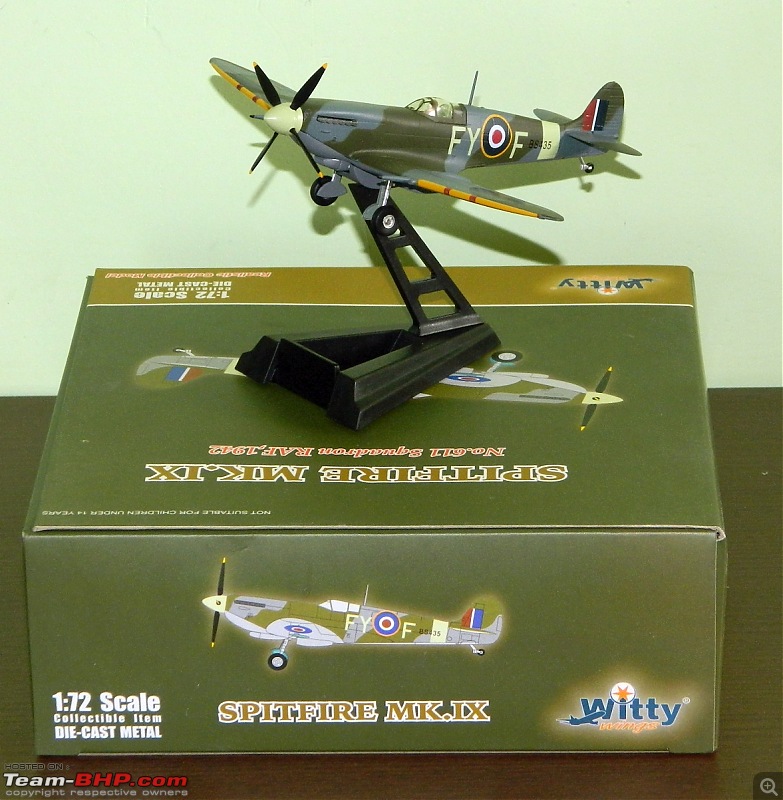 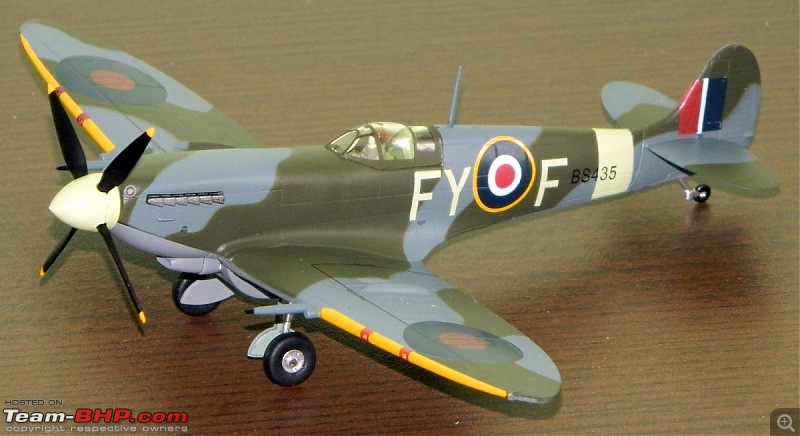 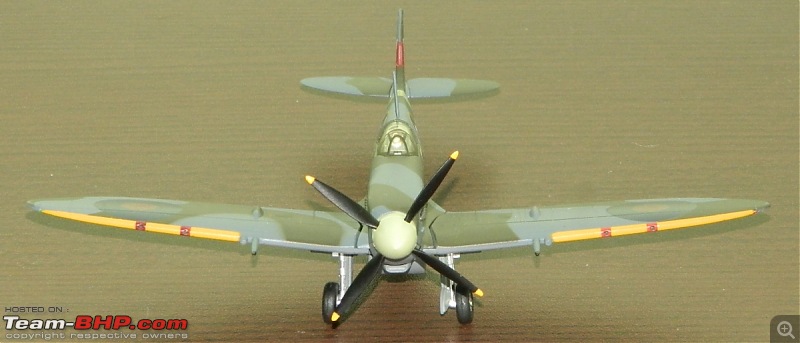 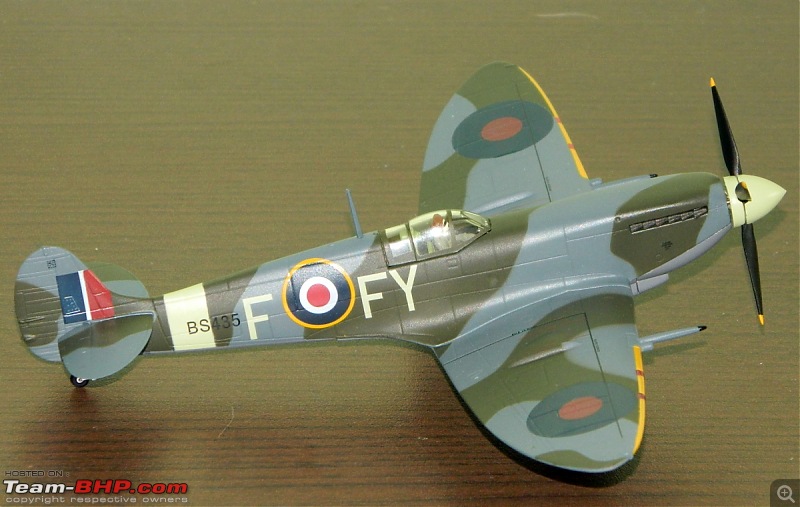 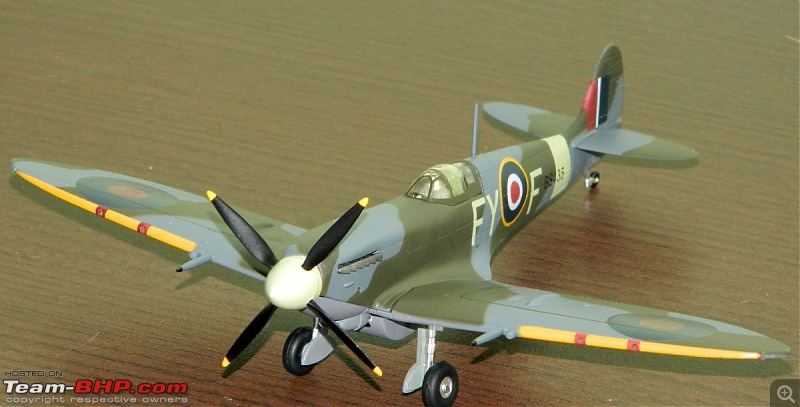 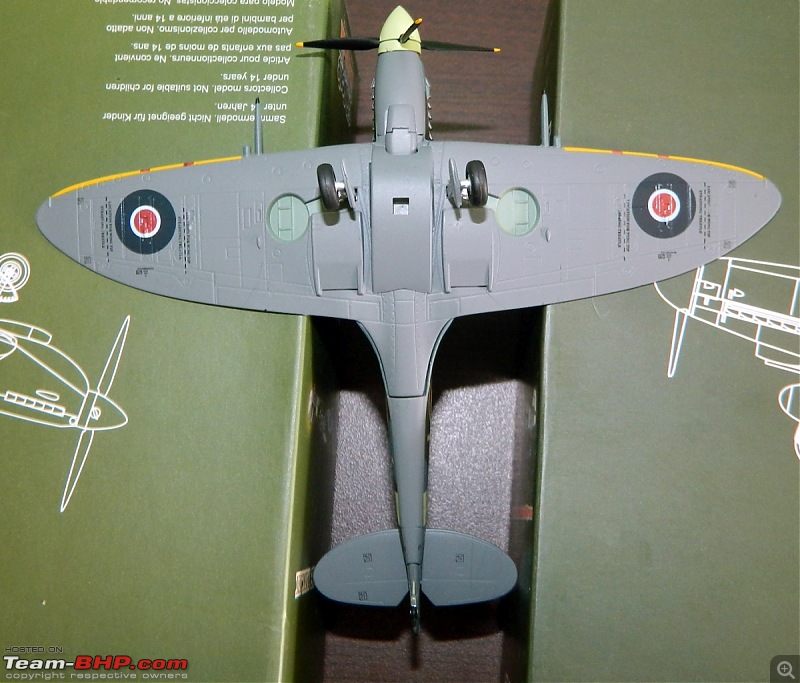 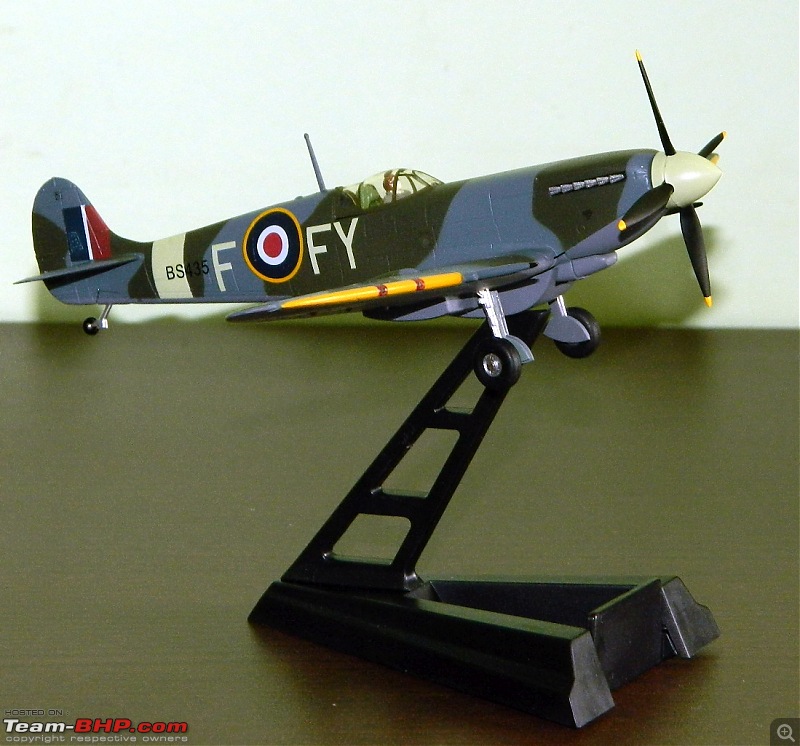 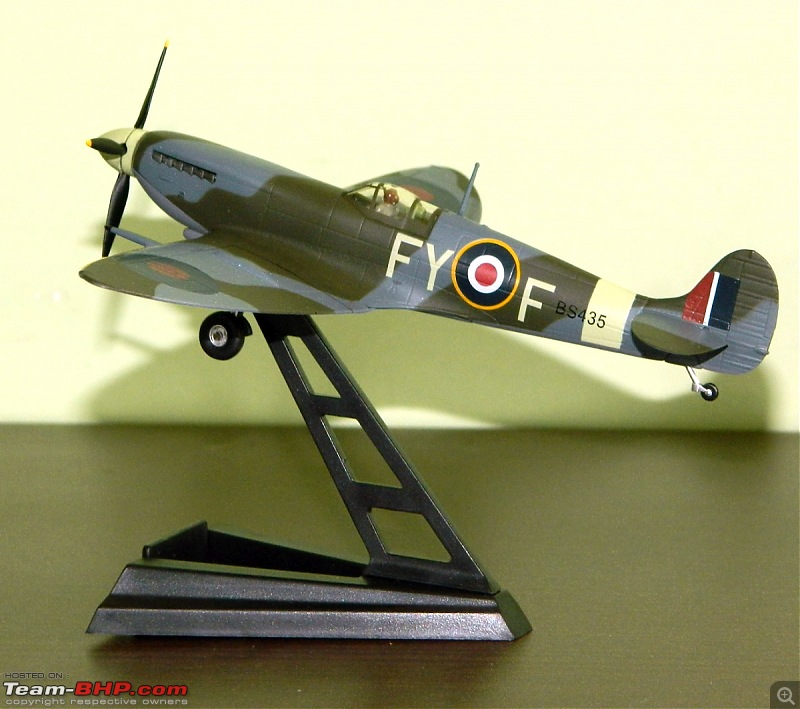 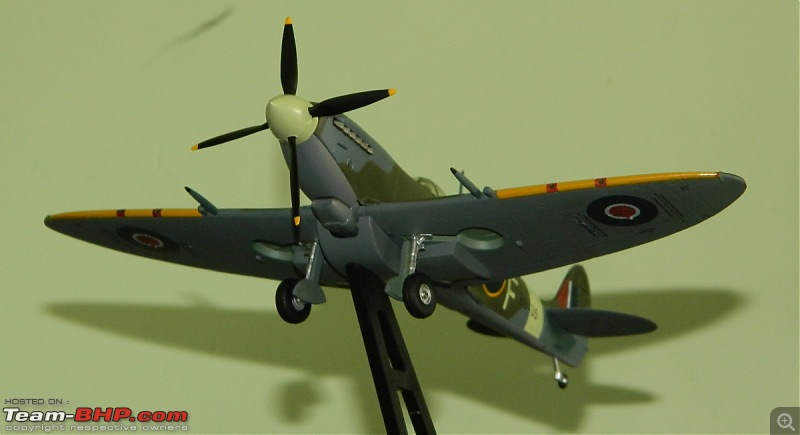 Spitfires and the Indian connection While RAF(Royal Air Force)units based in India had been operating Spitfires in the Photo Recce and Air Defence roles since late 1943,IAF Squadrons started converting to "handed down" ex RAF Spitfire marks,only towards the closing months of WW2. However,they did get to take part in the final actions in this theater of operations. Post Independence,the IAF picked up almost 100 late model Spitfires from ex RAF stocks placed in storage. These "Super Spitfire" FR Mk XVIIIs had arrived too late to take part in the War. This proved to be a good choice for the IAF,as some of these Spitfires were soon deployed to assist the Army in the Kashmir operations,where they played a crucial role.These Spits(along with some 2 seater trainer T Mk IXs) soldered on in the training role and helped in raising new Squadrons as the IAF expanded. In the end the Spitfire ended up staying in service longer then its intended replacement - the Hawker Tempest II. One of the final units(14 Sqn)relinquishing their Spitfires,transitioned almost directly to the Hawker Hunter,using the Vampire only briefly to help with the transition.That is how long into the jet age the IAF retained its Spitfires in Squadron service. Last edited by skanchan95 : 25th May 2019 at 11:58. |
| |  ()
Thanks ()
Thanks
|
| | #855 | |
| Senior - BHPian | re: Scale Models - Aircraft, Battle Tanks & Ships Spitfire Mk.IX versus BF109G6 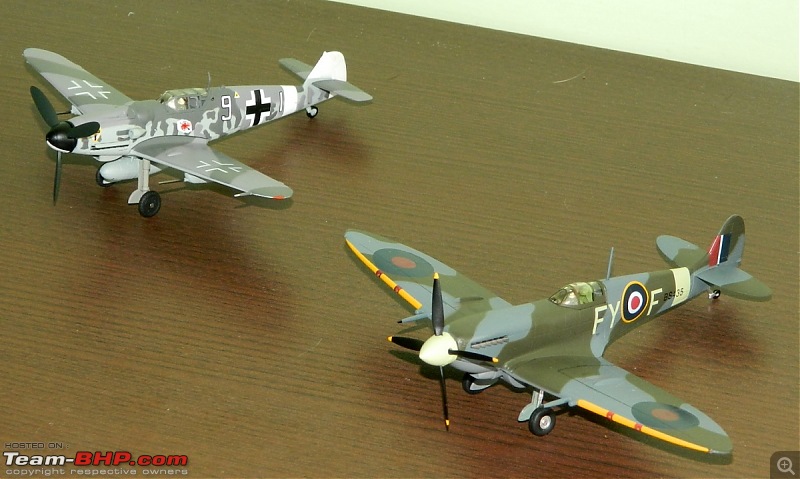 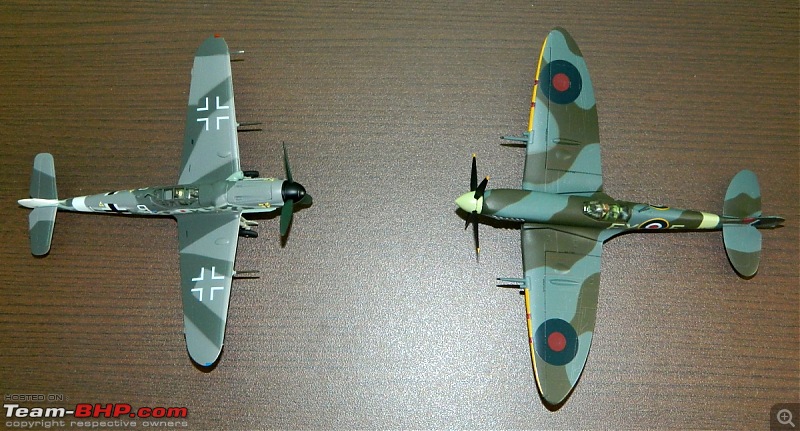  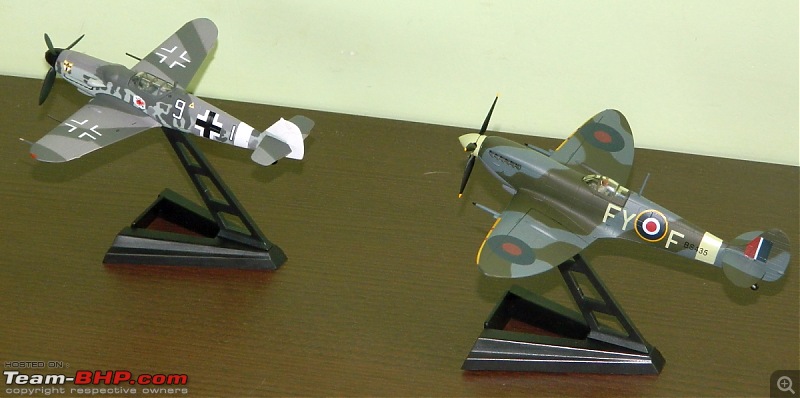 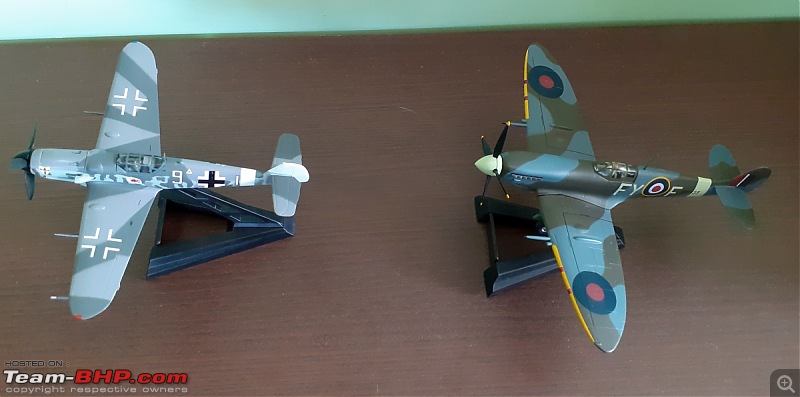 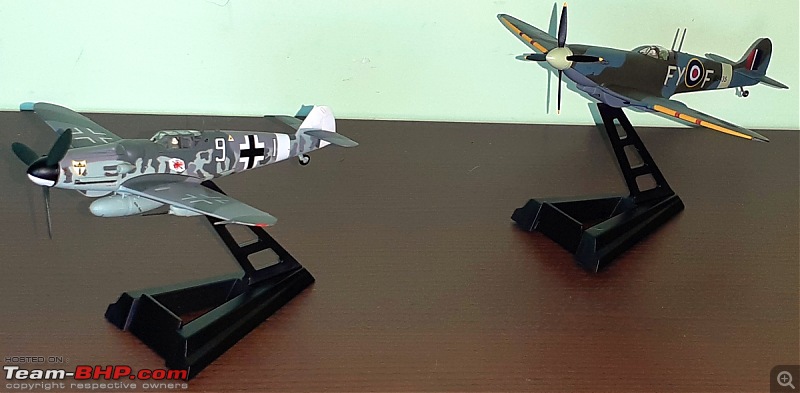 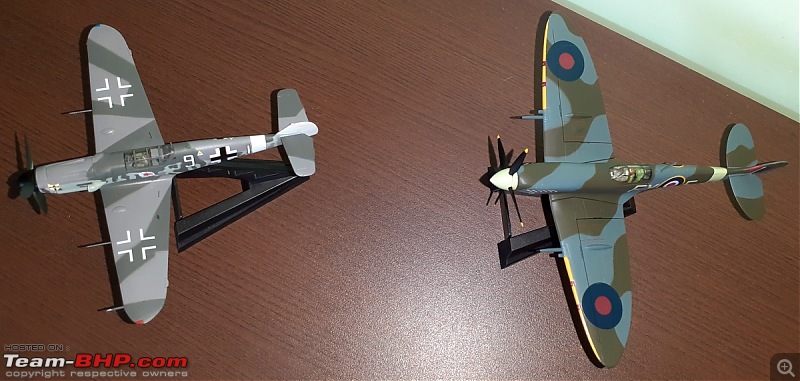 Quoting relevant parts from this article Quote:
There goes the siren that warns of the air raid Then comes the sound of the guns sending flak Out for the scramble we've got to get airborne Got to get up for the coming attack. Jump in the cockpit and start up the engines Remove all the wheelblocks theres no time to waste Gathering speed as we head down the runway Gotta get airborne before it's too late Running, scrambling, flying Rolling, turning, diving, going in again Running, scrambling, flying Rolling, turning, diving Run, live to fly, fly to live, do or die Won't you run, live to fly, fly to live, Aces high. Move in to fire at the mainstream of bombers Let off a sharp burst and then turn away Roll over, spin round to come in behind them Move to their blindsides and firing again Bandits at 8 o'clock move in behind us Ten ME-109's out of the sun Ascending and turning our spitfires to face them Heading straight for them I press down my guns. Rolling, turning, diving Rolling, turning, diving (doing it again) Rolling, turning, diving Rolling, turning, diving Run, live to fly, fly to live, do or die Won't you run, live to fly, fly to live, Aces high Last edited by skanchan95 : 25th May 2019 at 12:12. | |
| |  ()
Thanks ()
Thanks
|
 |



